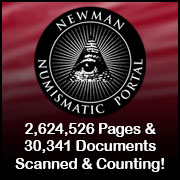
About UsThe Numismatic Bibliomania Society is a non-profit association devoted to the study and enjoyment of numismatic literature. For more information please see our web site at coinbooks.org SubscriptionsThose wishing to become new E-Sylum subscribers (or wishing to Unsubscribe) can go to the following web page link MembershipThere is a membership application available on the web site Membership Application To join, print the application and return it with your check to the address printed on the application. Print/Digital membership is $40 to addresses in the U.S., and $60 elsewhere. A digital-only membership is available for $25. For those without web access, write to: Charles Heck, Treasurer
AsylumFor Asylum mailing address changes and other membership questions, contact Chuck at this email address: treasurer@coinbooks.org SubmissionsTo submit items for publication in The E-Sylum, write to the Editor at this address: whomren@gmail.com BUY THE BOOK BEFORE THE COIN |
- WAYNE'S WORDS: THE E-SYLUM JULY 31, 2019
- NEW BOOK: AMERICA’S GREATEST TREASURE SHIP
- NEW BOOK: DIRECTORY OF CIRCULATING COINS 3RD ED.
- NEW BOOK: REFORMATIO IN NUMMIS
- NEW BOOK: TENNESSEE OBSOLETE PAPER MONEY
- NEW BOOK: PHILIPPINE EMERGENCY NOTES 2ND ED.
- BANKNOTE BOOK VENEZUELA CHAPTER PUBLISHED
- NEW BOOK: PAPER PAYMENT TOKENS IN ISRAEL
- NUMISMATIQUE ASIATIQUE JUNE 2019
- SIMON BENDALL (1937-2019)
- THE SEVIER FAMILY 1836 GOBRECHT DOLLAR
- VIDEO: 2019 SUMMER FUN OPENING CEREMONY
- INTERVIEW: CAC FOUNDER JOHN ALBANESE
- SUPPORT THE 2021 SILVER DOLLAR COMMEMORATIVES!
- NOTES FROM E-SYLUM READERS: JULY 28, 2019
- THE CASE OF THE WOODEN NICKELS
- QUERY: CEYLON BANKNOTE ESSAYS
- VOCABULARY TERMS: BACKGROUND, INCUSE, DIAGLYPH
- MORE ON CAMBISTS
- SAMUEL CHARLES BUSHNELL (1887-1957)
- HARVEY STACK'S NUMISMATIC FAMILY, PART 49
- FRANKLIN’S LIBERTAS AMERICANA MEDAL EXHIBIT
- DIX NOONAN WEBB RUSSIAN SALE SEPTEMBER 17, 2019
- ALAN V, WEINBERG PART II SELECTIONS
- THE OAK RIDGE DIME IRRADIATOR
- 1879 ANGLO-ZULU WAR VICTORIA CROSS EXHIBIT
- SAFE DEPOSIT BOXES AREN'T SAFE
- LOOSE CHANGE: JULY 28, 2019
- EXCHANGE RATE: ARTISTS WHO INCORPORATE MONEY
Click here to access the complete archive
To comment or submit articles, reply to whomren@gmail.com
Content presented in The E-Sylum is not necessarily researched or independently fact-checked, and views expressed do not necessarily represent those of the Numismatic Bibliomania Society.
WAYNE'S WORDS: THE E-SYLUM JULY 31, 2019
 This week we open with
SEVEN new numismatic books, a new periodical issue, the loss of Byzantine expert Simon Bendall, and updates from the Newman Numismatic Portal.
This week we open with
SEVEN new numismatic books, a new periodical issue, the loss of Byzantine expert Simon Bendall, and updates from the Newman Numismatic Portal.
Other topics this week include the Sevier Family 1836 Gobrecht dollar, John Albanese and CAC, the 2021 Silver Dollar legislation, Sam Bushnell, the Libertas Americana medal, irradiated dimes, and unsafe safe deposit boxes.
To learn more about numismatics of the Reformation, Tennessee obsolete paper money, Venezuelan banknotes, transitional pairs, aluminum counterfeit dimes, Woodstock, Ben Franklin, the Oak Tree Threepence, and the Case of the Wooden Nickels, read on. Have a great week, everyone!
Wayne Homren
Editor, The E-Sylum
NEW BOOK: AMERICA’S GREATEST TREASURE SHIP
Dave Bowers’ 2002 book, “A California Gold Rush History Featuring Treasure from the S.S. Central America" chronicled the history of the ill-fated steam ship whose wreckage yielded a jaw-dropping haul of gold in the 1980s. A second salvage operation visited the wreckage in 2014 and recovered additional material including another 1,000 ounces of California gold dust and nuggets and a cache of coins from the ship purser's safe. This long-awaited new book tells the story of the coins, ingots and other numismatic material found on the second visit. -Editor
 Never before revealed information about the greatest American treasure ever found, the tons of
California Gold Rush-era coins, ingots and gold dust recovered from the 1857 sinking of the S.S. Central America, the fabled “Ship of Gold,” are
revealed in an exciting new reference book written by acclaimed, award-winning rare coins researcher and writer Q. David Bowers with well-known numismatist
Dwight Manley.
Never before revealed information about the greatest American treasure ever found, the tons of
California Gold Rush-era coins, ingots and gold dust recovered from the 1857 sinking of the S.S. Central America, the fabled “Ship of Gold,” are
revealed in an exciting new reference book written by acclaimed, award-winning rare coins researcher and writer Q. David Bowers with well-known numismatist
Dwight Manley.
The new book, “America’s Greatest Treasure Ship: the S.S. Central America – the Second Treasure-Finding Journey,” publicly presents for the first time a useful and intriguing complete inventory of the more than 15,000 U.S. and world coins and 45 historic assayers’ ingots retrieved from the Atlantic Ocean during the last recovery expedition to the legendary ship in 2014. Many of these coins are among the finest known of their kind.
After sitting untouched on the ocean floor for more than a century, the treasure created a sensation when it was first discovered over 30 years ago. The amazing, initial 1980s recoveries from the S.S. Central America were described by LIFE magazine as “The Greatest Treasure Ever Found,” and the sale of the vast majority of that retrieved treasure still stands as the world’s most valuable numismatic transaction.
Bowers’ 2002 book, “A California Gold Rush History Featuring Treasure from the S.S. Central America,” quickly sold out and copies in the marketplace sell for more than the original issue price.
This latest reference is a companion book. It captures the history and romance of the Gold Rush and the fabulous first recovery, and then focuses on part two of the epic treasure find from the ocean floor, which in 2014 discovered such incredible, historic items as the ship purser’s safe filled with thousands of coins.
Readers of the new book will find fascinating revelations in the entertaining and informative Bowers’ style about these amazing sunken treasure discoveries, such as the unprecedented recovery of 1,000 ounces of California gold dust and nuggets still sealed in Old West miners’ packets (“pokes”) that had not been opened in 161 years. There also is captivating background information about the exciting California Gold Rush.
“As you read this book you are a part of history being made. Nothing like this has ever been found before!” explained Bowers, co-founder of Stack’s Bowers Galleries.
“The story of the S.S. Central America, its cargo, its lost passengers and crew and its survivors is a historic moment in American history, and the recovered items are an unprecedented time capsule of the wealth and adventure of the great California Gold Rush,” said Manley, managing partner of the California Gold Marketing Group which published the book.
The S.S. Central America was a 280-foot long, side-wheel steamship carrying tons of California gold when she sank off the coast of North Carolina in a September 1857 hurricane during a voyage from Aspinwall (now Colón), Panama to New York City. There were 578 passengers and crew on board, but only 153 survived.
The loss of the gold cargo more than 7,000 feet below surface of the Atlantic Ocean contributed to the economically devastating financial panic of 1857 in the United States that had begun in New York City in August.
The book’s foreword was written by Bob Evans, the chief scientist on the successful 1980s missions that first located and recovered a portion of the fabulous sunken treasure and who also supervised the treasure in the 2014 recovery expedition.
There are nearly 500 illustrations of Gold Rush history and numismatic importance in the new 224-page book, and many of the superb quality coin and ingot photographs are published for the first time anywhere.
Advance orders now are being taken for delivery of the book in late August. A limited number of copies will be available for purchase at the upcoming American Numismatic Association 2019 Chicago World’s Fair of Money® where Bowers, Manley and Evans will autograph books on Thursday and Friday, August 15 and 16.
“America’s Greatest Treasure Ship: the S.S. Central America – the Second Treasure-Finding Journey,” will be available for $49.95 (plus applicable taxes and/or shipping) from these S.S. Central America authorized dealers (in alphabetical order): Blanchard & Company (www.BlanchardGold.com); Finest Known (www.FinestKnown.com); Goldberg Coins & Collectibles (www.GoldbergCoins.com); and Universal Coin & Bullion (www.UniversalCoin.com).
NEW BOOK: DIRECTORY OF CIRCULATING COINS 3RD ED.
A new edition of the Directory of Circulating Coins is being published by Currency News. As with earlier editions, ultramodern numismatist Pabitra Saha provided information and images. -Editor

See How The World's Coins Are Changing
Worldwide, the coins being issued today are undergoing a transformation, combining unique technological innovations and new security features with novel
designs, details and materials. Keep up-to-date with these changes with the Directory of Circulating Coins.
Published by Currency News™, the Directory of Circulating Coins is the only guide to every circulating coin in the world – making it an invaluable reference and research tool.
This edition will see a more up to date and comprehensive version of the 2nd edition, last released in 2016. Featuring over 200 A4 pages covering the obverse and reverse of real size coins from all around the world, information on composition, weight, edge and security features amongst others.
The third edition will be published in October 2019. The directory is available in print and pdf formats.
"We use the Directory all the time. It is the most useful reference book we have" - The Royal Mint

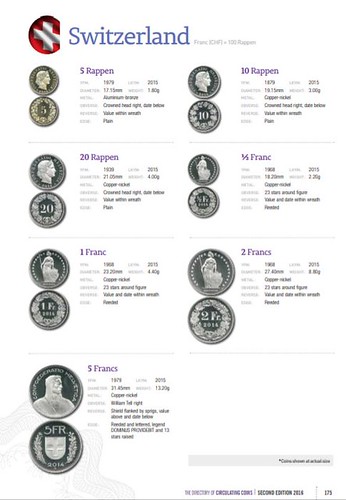
Every Coin, Every Country: One Indispensable Guide
The new directory provides detailed information on all the circulating coins in the world – including up-to-date information, specification and images in one
concise and easy-to-use volume.
This makes it an indispensable guide for anyone involved in the design, production, quality control, validation or use of coins.
- Over 200 A4 pages
- Covers every coin from the Afghani and the Ariary through to the Yuan and the Zloty
- Details of every denomination of each country’s circulating coins
- Includes real-size images of the obverse and reverse of each coin
- Features dates for Year First Minted and Last Known Year of Minting
- Information on composition, diameter, weight, edge detail, and description of motifs, security features and special notes.
I've never seen the book. Currency News is a trade publication for suppliers who sell material and equipment to coin-issuing governments. The first print copy is free to "Central Banks and Coin Issuing Authorities", but prohibitively expensive to non-subscribers.
The sample pages show that every coin is illustrated in color with short descriptions of the obverse, reverse and edge designs. No mintage figures are included - the book shows one entry per type with no breakdown by year. -Editor
From the Introduction:
... while there are plenty of reference guides to circulating banknotes in both digital and print form, there is no equivalent for circulating coins.
Given that there are some 55 mints around the world, between them producing around 50 billion circulating coins per year, this is somewhat surprising. Added to this, a growing range of technical innovations, new security features and materials, different shapes and edge detail, interesting subjects and designs, logical series and electroplated coins make the need for a simple reference guide such as this even more apparent.
For anyone involved in circulating coins – whether you are a central bank or issuer, mint, blank manufacturer, or supplier of equipment and systems for production, quality control, validation or coin accepting and vending systems – keeping abreast of such changes is critical. The Directory enables you to do so in a timely manner by bringing all the core information on coins together in one handy source.
I fondly remember my copy of Yeoman's Current Coins of the World. No longer published by Whitman, the last edition I'm aware of is the 1988 8th edition, revised and edited by Arthur and Ira Friedberg. But it's not true that no reference guide exists today - Krause's Standard Catalog of World Coins 2001-Date was updated just last year with the 2018 13th edition. But I suppose its fate rests now with Random House, the new owner of the title following the F+W media bankruptcy sales. There is also a publisher in Germany issuing guides to coins of the world, but I don't know if they cover present-day coinage. Do any of our readers know? -Editor
For more information, or to order, see:
New 2019 – Directory of Circulating Coins (3rd Edition)
(http://www.currency-news.com/publications/the-directory-of-circulating-coins/)
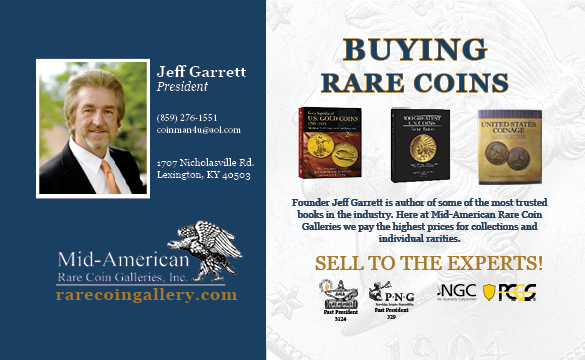
NEW BOOK: REFORMATIO IN NUMMIS
A new multivolume reference on numismatics of the Protestant Reformation has been published, Here is the press release. -Editor
A Life’s Work: The Rainer Opitz Collection “Reformatio in Nummis”
 The catalogue of the
Opitz collection has been published. The six-volume work comprises exactly 3,577 pages with more than 6,000 objects, which were collected by Rainer Opitz in
about 40 years on the subject of “Reformatio in Nummis”.
The catalogue of the
Opitz collection has been published. The six-volume work comprises exactly 3,577 pages with more than 6,000 objects, which were collected by Rainer Opitz in
about 40 years on the subject of “Reformatio in Nummis”.
((Reformatio in Nummis. Geschichte der Reformation und des Protestantismus. Annotierter Gesamtkatalog der Sammlung Rainer Opitz. Volume 2.1 to 2.6; edited by Rainer Opitz and written by Detlev Hölscher, Elisabeth Doerk, M.A. Klaus-Peter Brozatus. Hardcover edition, six volumes in three slipcases, 3,577 pages with colour illustrations throughout, Numismatischer Verlag Fritz Rudolf Künker GmbH & Co. KG, Osnabrück 2019. ISBN 978-3-941357-07-5. 399 euros + postage.))
The six volumes comprise exactly 3,577 pages, which were necessary to catalogue the Rainer Opitz collection in an appropriate way. They contain more than 6,000 objects, which were gathered in about 40 years by the collector with extensive knowledge and commitment. This catalogue published by Numismatischer Verlag Fritz Rudolf Künker GmbH & Co. KG is a new standard reference.
The Subject
At least since the auction of Prof. Robert Whiting’s collection in 1983, “Reformatio in Nummis” has been a very popular topic among collectors. It became even
more widespread and relevant because of the 500th anniversary of Luther’s posting of the theses in 1517. The Reformation is of unique importance. It is not
without reason that some historians consider it to be the beginning of the modern era. There is almost no other event that had such a large impact on the
history of the western world. Thanks to the desire of many believers to read the translation of the Bible in their own national language, reading literacy
spread to circles previously excluded from all kinds of education and many exclusively spoken languages were adapted to the new printing technique for the
first time. The numerous single-sheet prints, with the help of which the key messages of the Reformation were promulgated, did not only promote the spread of
the printing press but also made the publishing sector become a profitable industry. Therefore, within a short amount of time each university town had several
printing houses. The disputes caused by the Reformation did not only bring the victory of the territorial state over the state as association of persons, but
also a competition between the religions for moral superiority, which had far-reaching consequences on the personal piety of the population. Last but not
least: The fact that numerous groups refused to submit to the religion of the majority resulted in the establishment of permanent settlements in new regions of
the world.
All this has left numismatic marks. With the publication of the catalogue of the Rainer Opitz collection, the auction house Künker is pleased to present a comprehensive work, which contains everything that is related to the topic of the Reformation.
 Six Volumes
Six Volumes
The content is divided into six heavy-weighted volumes. These comprise:
• Luther Medals (No. 1-648)
• Medals on Persons (No. 649-1783)
• Medals on Events (No. 1784-4316)
• Miscellanea (No. 4317-4697)
Within the subgroups the material is sorted according to the time of its minting.
There is a historic theological comment about almost every person and every event that enables collectors to understand how they are connected to the Reformation. Each object is documented with an excellent photo made by Robert Raithel from Leipzig. Only the main types have their own number, the varieties struck from different metals are listed in the form “a-number”.
Each object is described according to all the rules of numismatics. Descriptions in foreign languages are translated. Not only the scholarly literature is given but also the occurrence of the piece on the auction market.
Where it is necessary, a numismatic comment supplements the information.
The Authors
Three authors are responsible for the creation of the texts.
Among them is Klaus-Peter Brozatus, who already edited the annotated inventory catalogue of the collection of coins and medals of the Luther Memorials Foundation of Saxony-Anhalt relating to the history of the Reformation published at Künker in 2015.
The second author, Elisabeth Doerk, has been working as a numismatist at auction house Künker since 2014. She has been enthusiastic about the connection between the Reformation and numismatics since she played a leading role in the organization of the exhibition “Reformatio in Nummis” at Wartburg castle.
The third author is Detlev Hölscher. He did not only write numerous texts but was also responsible for the final editing. To everybody who deals with coins Detlev Hölscher is known as an extremely diligent numismatist, who wrote numerous auction catalogues that are today considered standard references. The best-known is probably his catalogue of the Weweler collection “Lippia in Nummis”.
The Collector
 Dr. Rainer Opitz (1954-2019) collected
coins and medals since his earliest youth. In 1969 he purchased his first Reformation medal. It was a medal dedicated to the 450th anniversary of the
Reformation.
Dr. Rainer Opitz (1954-2019) collected
coins and medals since his earliest youth. In 1969 he purchased his first Reformation medal. It was a medal dedicated to the 450th anniversary of the
Reformation.
In 1981 one of his friends, a collector, encouraged him to devote himself entirely to this topic and to develop a collecting system. This might be one of the reasons why Rainer Opitz wrote his dissertation about the relation between religion and the military (“Das Verhältnis zwischen Religion und Militär”).
After a little more than a decade in the private sector, Rainer Opitz founded his own service company at the beginning of the 2000s, whose economic success enabled him to be active as a collector in such a systematic and extensive manner that he was able to collect more than 6,000 objects.

Rainer Opitz and Margot Käßmann at the vernissage at Wartburg in May 2014.
Rainer Opitz was enthusiastic about the subject and it was very important for him to share his enthusiasm with others. That is why he initiated – in collaboration with the auction house Künker – not only the publication of the collection of coins and medals of the Luther Memorials Foundation relating to the history of the Reformation, but also an exhibition that took place from 3 May 2014 to 31 January 2015 at Wartburg castle. Thus, more than a quarter of a million visitors had the opportunity to see this exhibition at no cost as part of their tour.
The Collaboration of Rainer Opitz and the Auction House Künker
It was very important for Rainer Opitz to make his collection accessible to a large community of collectors. When he decided in 2012 to sell his collection via
the auction house Künker in Osnabrück, they agreed to not only publish the auction catalogues but also a scholarly catalogue.
Unfortunately, Dr. Rainer Opitz did not live to experience the publication of this catalogue. He died on 7 February 2019 at the age of 64.
The quote written on his obituary notice could be the motto of this comprehensive catalogue, which outshines all standard references that have been published on this subject so far:
To achieve the possible, we must attempt the impossible again and again.
Hermann Hesse
The catalogue can be ordered at the sale price of €399 at the auction house Künker via email (service@kuenker.de), via telephone (+49 541 96
2020) or at the online shop:
https://www.kuenker.de/en/shop/stueck/231631
Postage and packaging within Germany amount to 15 euros. If you are living in another country, please ask the auction house Künker about the postage costs.
NEW BOOK: TENNESSEE OBSOLETE PAPER MONEY
Dennis Schafluetzel and Tom Carson have published a new book on the obsolete paper money of Tennessee. Congratulations! -Editor
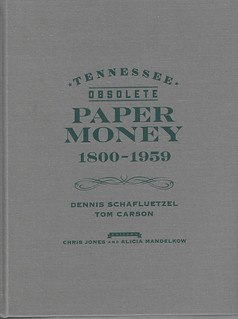

A new book that includes Tennessee obsolete currency, discovery banknotes and scrip as well as all existing published currency is available for sale from the authors Dennis Schafluetzel and Tom Carson. It includes a listing of all 3000+ known paper money issued from Tennessee between 1800 and 1959. It covers all paper money issued by: state authorized banks, private / unauthorized banks, the state, counties, cities, private merchants, companies and railroads.
The book includes history of the issuers, developed over 16 years, with a full color image of the notes, the rarity of the notes and the value of each type of currency based on the grade of the note. It also includes the listing of the known notes that were issued, but were not known to have survived. Each note listing includes the note identifiers under from Paul Garland’s book THE HISTORY of EARLY TENNESSEE BANKS AND THEIR ISSUES and from James A. Haxby’s book UNITED STATES OBSOLETE BANK NOTES 1782 -1866 (Tennessee section). The book includes tables for converting the new note identifier to the Garland and Haxby identifier. The table of contents and index make finding specific notes easy.
The book is self-published by the authors Dennis Schafluetzel and Tom Carson. The book retails for $110 (plus $10 domestic postage). For more information or to purchase a book, contact Tom Carson; 436 Lakecrest Drive; Harriman, TN 37748; Cell: 423-580-8115; tcarson@ewkm.net or Dennis Schafluetzel; 5208 W. 11th Street; Greeley, CO 80634; dennis@schafluetzel.org; Cell: 423-653-7908
NEW BOOK: PHILIPPINE EMERGENCY NOTES 2ND ED.
The second edition of Ken Berger's book about Philippine currency from the Japanese occupation in World War II has been published. Congratulations! -Editor
 Dr. Ken Berger recently updated his book about Philippine currency circulation during the Japanese
occupation in World War II, Philippine Emergency Notes: Counterstamped, Signed & Initialed (CSI) - Cebu Province (Second Edition). This update is
the product of three years of scholarly research and was only made possible through an Author’s Grant from the Central States Numismatic Society.
Dr. Ken Berger recently updated his book about Philippine currency circulation during the Japanese
occupation in World War II, Philippine Emergency Notes: Counterstamped, Signed & Initialed (CSI) - Cebu Province (Second Edition). This update is
the product of three years of scholarly research and was only made possible through an Author’s Grant from the Central States Numismatic Society.
The book is 35% larger than the first edition. It has greatly expanded upon the history behind these notes and includes the first extensive analysis of the 200K note Museo Sugbo (Cebu Provincial Museum) collection. This analysis was conducted in September/October 2017 by a team of six researchers led by Dr. Berger. The book also has a section that includes the first study undertaken on Mindanao CSI notes. It is the most extensive and detailed examination of the 1941 and 1942 Cebu and Mindanao Emergency Currency ever compiled, along with the counterstamps, signatures (& other script) and initials which are found on many of them.
The book has an initial printing of only 100 copies. It consists of 289 pages, along with a CD which contains color scans of all the notes and color pictures that appear in the book.
The world-renowned Philippine numismatics specialist, Neil Shafer, says “To have been able to bring this subject to its present state of perfection is a virtually unbelievable achievement; if a medal were to be given for accomplishing such an outstanding numismatic work, Ken would have to be among the first in line. Congratulations for this outstanding volume.”
Ray Czahor of Cookie Jar Collectibles, a well-known dealer and collector of Philippine numismatics, has stated, “All collectors of guerilla/emergency notes need this catalog to complete their library.”
The cost of the book is $30.00 plus $5.00 P&H. If so desired, a copy of the first edition can be included for an additional $6.00. Copies may be obtained from either the author at csinotes@juno.com or P.O. Box 90314, San Diego, CA 92169, or from Ray Czahor of Cookie Jar Collectibles at cookiejarpi@verizon.net or Box 428, Savage, MD 20763.
To read the earlier E-Sylum article, see:
NEW BOOK: PHILIPPINE EMERGENCY NOTES (https://www.coinbooks.org/esylum_v19n28a04.html)

BANKNOTE BOOK VENEZUELA CHAPTER PUBLISHED
Owen Linzmayer publishes The Banknote Book, a useful, constantly updated electronic reference. On July 26, 2019 he announced via email the availability of the chapter on the banknotes of Venezuela. It's available for $9.99. -Editor
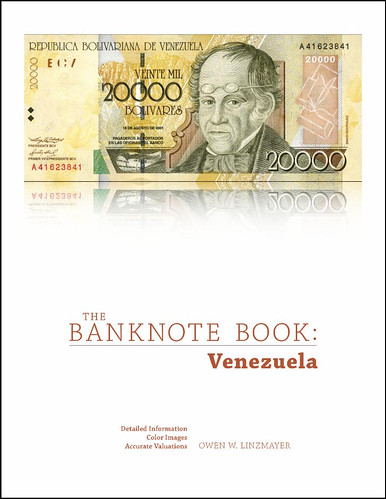 We're very pleased to announce that the Venezuela chapter is now available for individual sale and as a free
download to subscribers.
We're very pleased to announce that the Venezuela chapter is now available for individual sale and as a free
download to subscribers.
Venezuela (South America)
This 44-page catalog covers notes issued by the Estados-Unidos de Venezuela (United States of Venezuela) in 1811 to 1812, República de Venezuela (Republic of
Venezuela) from 1849 to 1861, and Banco Central de Venezuela (Central Bank of Venezuela) from 1940 to present. Published 22.07.2019.
Currently 282 chapters of The Banknote Book have been published as individual high-resolution PDF files. This represents a total of 5,869 pages covering 54,441 types and varieties.
For more information on The Banknote Book, see:
http://www.banknotenews.com/banknote_book/banknote_book.php
NEW BOOK: PAPER PAYMENT TOKENS IN ISRAEL
Only 100 copies have been printed of this new book on the paper payment tokens of Israel. The book is in Hebrew with a brief description in German. Here's the Google-translated text from the seller's site. Thanks to the July 23, 2019 issue of News & Notes from the society of Paper Money Collectors. -Editor
 Alexander Golberg: Catalog of Paper Payment Tokens in Israel
Alexander Golberg: Catalog of Paper Payment Tokens in Israel
282 pages, throughout (with a few exceptions) colored illustrations, format 213 x 305 mm, weight 1.5 kg, cardboard binding (hardcover) with thread stitching, self-published 2019,
Price about 60,00 Euro.
ISBN 978-965-572-704-3
golberga@yahoo.com
In his catalog, the author presents a collection area of ??notaphilia that is hardly known to us: paper payment tokens.
The catalog is written in Hebrew. This means that the book is read from "back" to "front" and from "right" to "left". Only the information on the issuer and the year of issue has been added by the author in English. The cover and the solid paper make a solid impression. When looking through the book, the viewer immediately notices that there is a lot of passion in him. Almost all bills are colored in original size.
The catalog is divided into ten sections (in brackets the number of issuing offices): Municipal expenditure (10), expenses of businesses (101), expenses of enterprises (85), expenses of restaurants (94), expenses of security forces (14), eg , Police, Ministry of Defense, Military, Charitable Organization (34), Medical Equipment Expenditure (8), Transport Company (18) Expenditure, Cooperative (44) Expenditure, and Cooperative Settlement (32) Expenditure around co-operatively organized, rural settlements, in which unlike in the kibbutzim private property is allowed.
The catalog covers all related issues in the area of ??contemporary Israel from the time of the Ottoman rule to the British mandate administration in Palestine until today.
In the expenditure no prices are called, but each note is assigned to a rarity group. RRR means that only 1 - 2 specimens of this exhibit are known, RR 3 - 5, R 6 - 10, and all others the estimated amount present.
The author summarizes the monetary concept very far, so he took z. For example, banknotes whose equivalent is a breakfast, lunch or similar or which give a buyer a discount on the purchase of goods. It should be noted that some of the paper payment stamps are not only written in Hebrew, but also in English, French and German.
The catalog, published in a mini edition of only 100 copies, can certainly be recommended to any interested collector of paper money.
For more information, or to order, see:
Golberg: Catalog of Paper Payment Tokens in Israel
(https://www.geldscheine-online.com/post/golberg-catalog-of-paper-payment-tokens-in-israel)
NUMISMATIQUE ASIATIQUE JUNE 2019
Here are the contents of the latest issue of Numismatique Asiatique. -Editor
 Editorial :
Editorial :
Inauguration à Phnom Penh du musée de l'Economie et de la Monnaie, le "Sosoro Museum".
Indochine / Annam :
About the Monnaies de l'Empire d'Annam (1849)
by Craig GREENBAUM
Tibet :
Early Tibetan Silver Tangkas
by Wolfgang BERTSCH
Inde :
Les médailles de l'Inde Française
par Daniel CARIOU
Japon : La datation des hansatsu
par Jean-Yves LEFEVRE
Chine :
A propos de monnaies chinoises trouvées au Yukon
par François JOYAUX
Archives :
Le délabrement du sytème monétaire chinois vers 1900.
Divers :
- Ve Rencontres de Numismatique Asiatique, à la Monnaie de Paris, le 23 novembre 2019.
- Addenda au "Répertoire des anciennes collections françaises de monnaies d'Extrême-Orient"
- Addenda & errata à Monnaies impériales d'Annam.
66 pages en couleurs. Format : 21 x 29 cms.
For more information, see:
https://sites.google.com/site/societedenumismatiqueasiatique/revue

SIMON BENDALL (1937-2019)
Some readers have asked about Byzantine coin specialist Simon Bendall, who passed away recently. I didn't know him, but I've been able to gather the following. Other comments and remembrances would be appreciated. -Editor
From Wikipedia:
Simon Bendall (1937 – 2019) was a numismatist specialising in Byzantine coins. He wrote the first major work on the coinage of the Empire of Trebizond.
After finding a Roman coin as a teenager, Bendall became a collector, researcher and dealer in ancient coins. After leaving Cheltenham College, he did military service (1956-58), partly in Germany, then studied part-time at the Institute of Archaeology, University of London (1962-1965), while working in the coin department of Spink & Son (1959-1965). He was later elected a Fellow of the Society of Antiquaries.
Bendall worked for several specialist coin dealers: the coin department of Spink & Son (1959-1965), A.H. Baldwin (1967-1987), Numismatic Fine Arts in Los Angeles (1987-1988), and in 1998 catalogued the first sale of the Byzantine gold coins from the Nelson Bunker Hunt Collection for Sotheby’s, New York. In the 2000s he rejoined Spinks in London (2006-2010). He was elected as an Honorary Fellow of the Royal Numismatic Society in 2010. His collection of Byzantine coins was stolen in London in February 2018.
In his A Corner of Tenth-Century Europe blog, Jonathan Jarrett writes:
... Simon didn’t use e-mail, and barely used computers; the only practical way to send him a PDF was in print, and all the correspondence I had with him was actual letters, answered in longhand and in scrupulous detail...
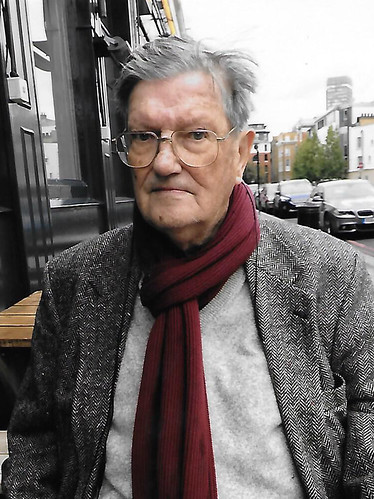 ... Simon was one of the people who had
written about the concave fabric of later Byzantine coins, and one of the very few who had asked the important question: well, how did they do it? And by then
I was also aware that for the coinage of the last and longest-lasting dynasty of Byzantine emperors, the Palaeologans, the standard reference was by one Simon
Bendall...
... Simon was one of the people who had
written about the concave fabric of later Byzantine coins, and one of the very few who had asked the important question: well, how did they do it? And by then
I was also aware that for the coinage of the last and longest-lasting dynasty of Byzantine emperors, the Palaeologans, the standard reference was by one Simon
Bendall...
And in fact, I now learn, a full bibliography of his work would have two-hundred-plus things in it, from two- or three-page notes in the little auction house periodicals we used to have to full-length monographs, because he just knew a lot, largely through his ongoing connections with those same auction houses as employee and then consultant expert. Numismatics is one of the last fields where you don’t have to be an academic to be a major contributor, and that is not least because of the demonstrable importance of the work of people like Simon.
In her Newsletter #122 Shanna Schmidt writes:
I learned a few weeks ago of the passing of my old friend Simon Bendall. Simon was a scholar of Byzantine numismatics, as well as author of numerous articles and books. He was a contributing author to the numismatic staple, Byzantine Coins and Their Values by David Sear. Aside from being brilliant in his area of expertise, he also was a kind man and a lot of fun to know. I met Simon when I was a young girl as he helped to do attribution work for my father’s firm off and on. When I was in my early 20’s I had the fortune of working for a short time with Simon in London. In the last years his health was not wonderful so when I learned of his death it came as no big surprise. That said, I lament at the loss the numismatic world will experience with his passing. There is a nice article about him in this week’s Coinsweekly.
Andy Singer writes:
Simon was a frequent visitor to the Washington DC area where he went to research the Byzantine collection at Dumbarton Oaks, joining other scholars such as Cecile Morrisson and Philp Grierson. He also attended meetings of the Washington Ancient Coin Club and brought coins for sale from the stock of A. H. Baldwin and Sons. His presence would enlighten every meeting.
Thanks, everyone, including Mike Markowitz, who pointed out Jonathan Jarrett's blog entry. -Editor
To read the Wikipedia article, see:
Simon Bendall (https://en.wikipedia.org/wiki/Simon_Bendall)
To read two CoinsWeekly articles, see:
Simon Bendall (1937-2019) (https://coinsweekly.com/simon-bendall-1937-2019/)
Bendall, Simon (https://coinsweekly.com/whoswho/bendall-simon/)
THE SEVIER FAMILY 1836 GOBRECHT DOLLAR
The latest addition to the Newman Numismatic Portal is a video on the Sevier family 1836 Gobrecht dollar. Project Coordinator Len Augsburger provided the following report. -Editor
An 1836 Gobrecht Dollar With (Mostly) Unbroken Provenance

A recent addition of the Newman Portal is a video produced by David Lisot, The Andrew Jackson / Earl / Sevier Flying Eagle Gobrecht Dollar, which traces the path of an 1836 Gobrecht dollar from President Andrew Jackson to Ralph Earl (the “court painter” during Jackson’s White House years) to the Sevier clan, an important Tennessee family. The coin remained in the family for many years until several years ago when it was sold to a well-known dealer of Liberty Seated coinage. Soon after selling the coin, the Sevier descendant discovered a letter in an old family bible detailing the coin’s provenance. Alas, the coin had already disappeared into the channels of numismatic commerce. Could the coin be reunited with the documentation? LSCC Education Director John Frost tells the story in a presentation from the March 2019 Whitman Baltimore Expo.
Image: 1836 Gobrecht dollar, a family bible, and an 1888 letter from the Sevier family.
Link to The Andrew Jackson / Earl / Sevier Flying Eagle Gobrecht Dollar video on Newman Portal:
https://nnp.wustl.edu/library/book/562810
VIDEO: 2019 SUMMER FUN OPENING CEREMONY
These are selections from the David Lisot Video Library that feature news and personalities from the world of coin collecting. David has been attending coin conventions since 1972 and began videotaping in 1985. In 2017 the Newman Numismatic Portal reached an agreement to list all David’s videos on their website. Each week an excerpt of a different video is available on the CoinTelevision YouTube channel.
Here's one on the 2019 Summer FUN Opening Ceremony. -Editor

Bob Hurst, President, Florida United Numismatists, David Lisot, Video Producer, CoinTelevision.com. Another summer coin convention for the Florida United Numismatists. President Bob Hurst introduces his Board of Directors and open the show.
The entire interview is available on the Newman Numismatic Portal at:
https://nnp.wustl.edu/library/multimediadetail/522852
An excerpt of the video is available for viewing on the Coin Television YouTube Channel at:
https://youtu.be/EeBGaGoNPdw
FUN Summer Opening Ceremony July 11, 2019
22:09
Bob Hurst, President, David Lisot, Interviewer, CoinTelevision.com with Hunter Falkman, John McIntosh, George Watson, & John Yasuk.

INTERVIEW: CAC FOUNDER JOHN ALBANESE
In a Coin Dealer Newsletter blog article published July 26, 2019, Joshua McMorrow-Hernandez interviewed John Albanese, founder of Certified Acceptance Corporation (CAC). With permission, here's a long excerpt from the interview's preface; see the full article online for the complete interview. Congrats to the CDN graphic designer for a great image! -Editor
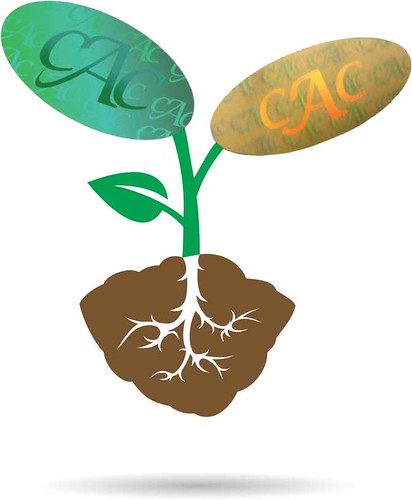 For more than four decades, John Albanese has
been a numismatic thought leader, bringing innovation to an ages-old hobby and helping redefine how collectors and the marketplace understand the quality and
condition of coins. In 1986, Albanese co-founded PCGS, and a year later established his own third-party grading firm, NGC. The creation of those two
organizations revolutionized the coin industry, providing industry standards for consistent grading and offering a greater sense of security to the collectors
and dealers who wanted authentic and accurately graded coins. While a novelty at first, the encapsulation of coins rapidly became commonplace.
For more than four decades, John Albanese has
been a numismatic thought leader, bringing innovation to an ages-old hobby and helping redefine how collectors and the marketplace understand the quality and
condition of coins. In 1986, Albanese co-founded PCGS, and a year later established his own third-party grading firm, NGC. The creation of those two
organizations revolutionized the coin industry, providing industry standards for consistent grading and offering a greater sense of security to the collectors
and dealers who wanted authentic and accurately graded coins. While a novelty at first, the encapsulation of coins rapidly became commonplace.
By the 2000s, tens of millions of coins across the entire spectrums of grade, type, and period found their way into sonically sealed plastic. While NGC and PCGS have maintained the most consistent and rigorous of grading standards of all third-party graders, over time the inevitable happened—some slabbed coins of similar grade were simply better than others. One could place a few coins certified by the same company of identical type, date, and labeled grade and find that, perhaps, one or two really stood out from among the rest. And, invariably, less market receptivity for average or subpar pieces for a given grade could drag down prices for the best examples of the same grade—coins deserving of their own market.
What to do? Albanese had the answer. In 2007, he founded CAC with a mission to help premium-quality coins stand out from the rest by creating a separate market for them. For a fee, CAC evaluates coins slabbed by NGC and PCGS, awarding one of two possible seals of approval for coins of excellent quality and overall outstanding eye appeal for their labeled grade. Pieces determined to be at the top of their class for their grade receive a small green sticker on their slabs. Meanwhile, coins that are undergraded and would still qualify for a green sticker, even if graded one point higher, are bestowed a gold CAC seal.
The coins CAC has labeled, bearing shiny bean-shaped green or gold stickers, have performed well in both in day-to-day trading as well as in high-profile auction appearances. “Beaned” coins have performed remarkably well, trading for premiums ranging from about 10% to 90% and even more, as opposed to their identically graded but non-CAC counterparts. Prices for many of the most actively traded CAC coins have also been increasingly represented in The CDN Monthly Greysheet, further reflecting the fact that CAC coins have built a solid niche in the market.
CAC has now stickered more than 1.1 million coins with a combined insured valued of $5.5 billion and has an ever-growing network of member dealers.
To read the complete article, see:
Magic Beans: How Green & Gold Stickers Sprouted A New
Marketplace (http://blog.greysheet.com/magic-beans-how-green-gold-stickers-sprouted-a-new-marketplace/)
To visit the CAC web site, see: https://www.caccoin.com/
SUPPORT THE 2021 SILVER DOLLAR COMMEMORATIVES!
Last week I mentioned the new legislation calling for 2021 commemorative silver dollars. But don't forget that the operative word here is "legislation". It's not in law yet - far from it. The bill faces many hurdles before it can become law and make the new coins a reality. U.S. collectors and their hobby leaders must ACT and let their voices be heard in the halls of Congress. Here's a press release from PAN; they've helped the idea get this far - now it's up to the rest of us to make it happen. -Editor
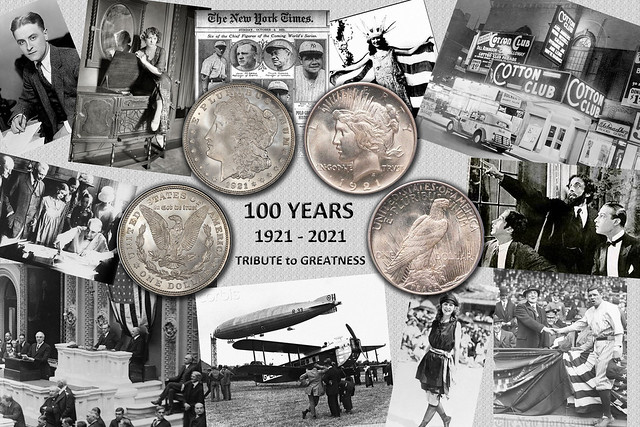
The Pennsylvania Association of Numismatists is calling on all fellow coin collectors to contact their United States Congressional Representatives to co-sponsor H.R. 3757 commemorative coin legislation.
This House Bill will require the Secretary of the Treasury to mint coins in commemoration of the centennial of the minting of the Morgan dollar and the Peace dollar and shall mint and issue not more than a total of 500,000 one dollar coins of which shall weigh 26.73 grams; have a diameter of 1.500 inches; and contain not less than 90 percent silver. Coins minted under this Act shall be issued in uncirculated and proof finishes.
PAN President and Citizens Coinage Advisory Committee Chairman Thomas Uram and fellow CCAC member Michael Moran came up with the idea of the recreation of these popular silver dollars in 2021. The Morgan Dollar was the workhorse of American industry came to an end in 1921 and the new Peace Dollar commemorating the declaration of peace between the United States and the Imperial German government in 1921.
The sale price of the coins has yet to be determined. The important aspect to this program is that 40% of the surcharges will be used to support numismatic education and will be administered by the American Numismatic Association as required by law. The surcharges that have traditionally funded many causes and projects over the history of commemorative coin programs will actually be used to support numismatics for the first time ever. It is high time that the collectors that have financially supported these past programs will now reap a benefit within our own collecting community!
We are asking all numismatic organizations to support this effort and urge all of their members to contact their Congressional Representative. One hundred eighty nine members of the House of Representatives are needed to co-sponsor this Bill to make these coins a reality. Collector support is essential to get this legislation into law. More information at www.PANcoins.org
Find Your Representative by Zip Code: https://ziplook.house.gov/htbin/findrep_house?ZIP=
So - what are you waiting for? Contact your congressional representative's office! See the PAN web site, where there is more information and a flyer your can print out for distribution to friends and fellow collectors.
For more background on the program, see Lou Golino's excellent article for CoinWeek. Here's an excerpt. -Editor
Mr. Uram also noted that many past commemorative coin programs have failed to reach their potential because the members of Congress and staff members who write the enabling legislation are typically not collectors and may not know what collectors want.
In this case, he and Mr. Moran decided that as the legislation was drafted that it be done with input from each of them. They are both lifetime collectors who have a good sense of what collectors want.
Both also stressed the importance of the coins being dated “2021”, not a dual date as is sometimes used on coin issues that celebrate anniversaries. As Mr. Uram said, “The next slot in your silver dollar album after 1921 should be 2021.”
Asked whether the Mint might be able to use the original dies from 1921 of both coins, Mr. Uram said that what is more likely is that perhaps the original plaster models of the designs could be used and that he is working with the Mint on this. Converting the plaster designs into the 3D graphic system that Mint artists use today will be key. Current Chief Engraver Joseph Menna is well-known for working that way.
To read the complete article, see:
A
Coin Analyst Exclusive: An Insider’s Perspective on the Morgan & Peace 1921 Commemorative Silver Dollar Coin Act
(https://coinweek.com/modern-coins/a-coin-analyst-exclusive-an-insiders-perspective-on-the-morgan-peace-1921-commemorative-silver-dollar-coin-act/)
For more tools on the ANA web site, see:
Support Coin Legislation H.R. 3757 (https://www.money.org/coin-legislation)
To follow the path of the legislation, go to the House web site and click "get alerts." I did!: https://www.congress.gov/bill/116th-congress/house-bill/3757
To read the earlier E-Sylum article, see:
WAYNE'S NUMISMATIC DIARY: JULY 21, 2019
(https://www.coinbooks.org/v22/esylum_v22n29a20.html)
NOTES FROM E-SYLUM READERS: JULY 28, 2019
The Coining Woman
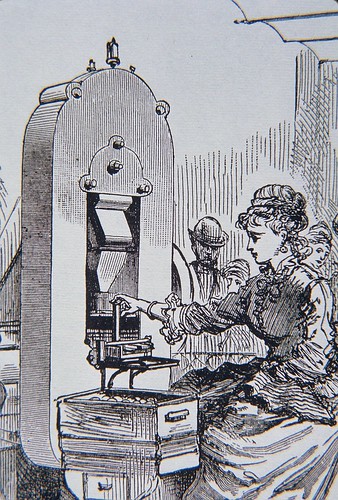 Gary Greenbaum writes:
Gary Greenbaum writes:
The line art of the woman coining is taken from page 38 of George Evans’s “Illustrated History of the United States Mint” which went through several editions in the late 19th century
I thought that looked familiar! Thanks. -Editor
To read the earlier E-Sylum article, see:
OLD COIN-RELATED LINE ART (https://www.coinbooks.org/v22/esylum_v22n29a15.html)
Portraits of Joseph Wharton Sought
Dennis Tucker of Whitman Publishing writes:
I’m looking for print-resolution (300 dpi, ideally at 6 x 9 inches) portraits or other photographs of nickel industrialist Joseph Wharton, preferably dating from the 1860s or earlier. I’ve searched the Newman Numismatic Portal and I have queries out to the Wharton School of Business and other potential archival sources, but figured I’d check with the readership of The E-Sylum, as well. Anyone with a lead can reach me at dennis.tucker@whitman.com.


1904 Joseph Wharton International Nickel Company Medal
Wharton was an important figure in the creation of our modern five-cent coin, and bibliophiles know him for his 1877 pamphlet entitled Memorandum Concerning Small Money and Nickel Alloy Coinage. Can anyone help? -Editor
Transitional Pairs
Dave Lange writes:
Tom Caldwell wrote in suggesting that collectors seek coins having different designs of a single denomination and struck during a single year. I wrote a series of columns on that very topic of "Transitional Pairs" for The Numismatist, and these ran April-September of 2012.
I imagine that most readers of The E-Sylum are ANA members and can access those columns online but, for those who are not ANA members, the same columns are reprinted at the NGC website, dated March-August, 2013.
Well, five of the six parts are on the NGC site, but Part Three is apparently missing in action - I was unable to locate it. But fear not - as Dave mentioned, it should be available in The Numismatist archives on the American Numismatic Association site. -Editor
To read the Transitional Pair articles, see:
USA Coin Album: Transitional Pairs - Part One
(https://www.ngccoin.com/news/article/3222/USA-Coin-Album-Transitional-Pairs-Part-One/)
USA Coin Album: Transitional Pairs - Part Two
(https://www.ngccoin.com/news/article/3258/USA-Coin-Album-Transitional-Pairs-Part-Two/)
USA Coin Album: Transitional Pairs - Part Four
(https://www.ngccoin.com/news/article/3387/USA-Coin-Album-Transitional-Pairs-Part-Four/)
USA Coin Album: Transitional Pairs - Part Five
(https://www.ngccoin.com/news/article/3430/USA-Coin-Album-Transitional-Pairs-Part-Five/)
USA Coin Album: Transitional Pairs - Conclusion
(https://www.ngccoin.com/news/article/3486/USA-Coin-Album-Transitional-Pairs-Conclusion/)
To read the earlier E-Sylum article, see:
NOTES FROM E-SYLUM READERS: JULY 21, 2019 : More Creative Collections
(https://www.coinbooks.org/v22/esylum_v22n29a13.html)
Vertical Lines on U.S. Dollar Bill

Drage Vukcevich writes:
 Here's an unusual $1 note, and I hope you can see the two lines on the right side. See if you readers have
any idea. If someone hasn't added these lines as a hoax, then this has to be some kind of amazing BEP error.
Here's an unusual $1 note, and I hope you can see the two lines on the right side. See if you readers have
any idea. If someone hasn't added these lines as a hoax, then this has to be some kind of amazing BEP error.
Anything can happen to a note after it hits circulation. If these lines were added by someone after the fact they were awfully precise. I doubt if this is a Bureau of Engraving and Printing error, but I've never seen anything like this before. What do people make of it? -Editor
More Micronation Coins
Mike Marotta writes:
 I also have a Minerva 35-dollar bimetallic gold-silver coin. The story of Minerva and many other attempted
"micronations" appears in How to Start Your Own Country by Erwin S. "Filthy Pierre" Strauss (Loompanics, 1979; Breakout, 1984). Ayn
Rand's Atlas Shrugged, stimulated many people to at least talk about starting new communities Operation Atlantis, also a libertarian venture of the
1970s, minted 10-gram silver "deca" coins in two varieties, plain and reeded edge. Again, their story is in the Strauss book.
I also have a Minerva 35-dollar bimetallic gold-silver coin. The story of Minerva and many other attempted
"micronations" appears in How to Start Your Own Country by Erwin S. "Filthy Pierre" Strauss (Loompanics, 1979; Breakout, 1984). Ayn
Rand's Atlas Shrugged, stimulated many people to at least talk about starting new communities Operation Atlantis, also a libertarian venture of the
1970s, minted 10-gram silver "deca" coins in two varieties, plain and reeded edge. Again, their story is in the Strauss book.
Perhaps the most common monetary media are the notes issued by Hutt River Principality, which is surrounded by Australia and completely unassociated with Ayn Rand or the libertarians. Allow me to suggest that for that very reason HRP is a venture with several decades of nominal success. Their website is here: http://www.principality-hutt-river.com and was recently updated.
The Principality of Sealand (https://www.sealandgov.org) also remains successful. They, too, issue stamps and coins. Sealand survived on a workable business plan, radio broadcasts that are more interesting than BBC fare.
On the other hand, the Internet has spawned a swarm of "cinderellas" that have no other reality except to sell their postage stamps and paper currencies.

Hutt River Principality Notes
To read the earlier E-Sylum article, see:
NOTES FROM E-SYLUM READERS: JULY 21, 2019 : More on the Republic of Minerva Coin
(https://www.coinbooks.org/v22/esylum_v22n29a13.html)
Counterfeit Aluminum Dimes?
Dave Schenkman writes:
I found this while looking for something else, and thought it might be of interest.

Absolutely! I've certainly never heard of contemporary counterfeit dimes (or any coin) in aluminum. This is from The Marshfield News and Wisconsin Hub (Marshfield, Wisconsin), Thursday, Jan 4, 1894, Page 10. Has anyone even seen an aluminum dime counterfeit? -Editor
Rent-A-Coin?
Regarding the company that offers fractional shares in major collectibles, David Gladfelter writes:
If we can securitize mortgages, why not coins and other collectibles? How about Rent-A-Coin? The lessee would have to pay for appropriate insurance coverage, of course. Museum curators put together great exhibitions by borrowing items from other museums and from collectors. Can, and should, this be permitted for competitive numismatic exhibits?
How about numismatic time shares? How about trusts, life estates and remainder interests in numismatic property? Unfortunately, nothing I collect is valuable enough to make such property concepts practical, but just wait, it will happen sooner or later.
To read the earlier E-Sylum article, see:
APP OFFERS FRACTIONAL SHARES OF MAJOR COLLECTIBLES
(https://www.coinbooks.org/v22/esylum_v22n29a29.html)
More on Strange Good Luck Symbol
In the still-haven't-found-what-I'm-looking-for department, Craig Murray writes:
 Your 2010 article "SO WHAT IS
THIS STRANGE 'GOOD LUCK' SYMBOL?" has reference to my web site about the symbols being Runic Symbols which I no longer believe. They could be
hieroglyphs as I now state but it make no sense. I have been looking to the meaning for years and have not found anything helpful. I have looked up Hobo
symbols and Native American symbols and others but with no luck.
Your 2010 article "SO WHAT IS
THIS STRANGE 'GOOD LUCK' SYMBOL?" has reference to my web site about the symbols being Runic Symbols which I no longer believe. They could be
hieroglyphs as I now state but it make no sense. I have been looking to the meaning for years and have not found anything helpful. I have looked up Hobo
symbols and Native American symbols and others but with no luck.
Thanks for the update. Can any of our readers assist? Contact Craig Murray at TheHiker@sageventure.com . -Editor
To read the earlier E-Sylum articles, see:
QUERY: WHAT IS THIS STRANGE 'GOOD LUCK' SYMBOL?
(https://www.coinbooks.org/esylum_v13n25a27.htm)
SO WHAT IS THIS STRANGE 'GOOD LUCK' SYMBOL?
(https://www.coinbooks.org/esylum_v13n26a18.html)
Apollo 11, Woodstock Elongateds Offered
Oded Paz passed along this announcement of his two latest elongated cent designs celebrating the 50th Anniversaries of Apollo 11 and Woodstock. Groovy. -Editor

The prices are:
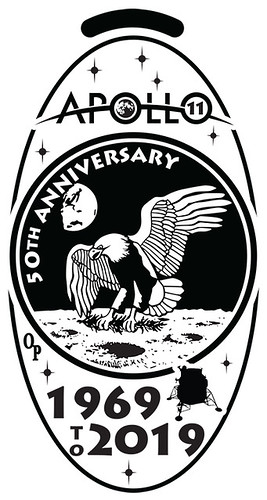 Copper Cents, random dates
@ $2 (or $4 for both designs)
Copper Cents, random dates
@ $2 (or $4 for both designs)
Copper Cents dated 1969, with raised back (with the date) – Mintage: 125 pcs, @ $3 (or $6 for both designs)
Full denominational set, with randomly dated Copper Cent, Nickel, Dime and Quarter - Mintage: 50 sets @ $10 per each set (so $20 for both sets)
Susan B Anthony Apollo 11 Dollar, with raised back (with the design that is similar to the EC) - Mintage: 25 @ $5
Shipping: 1-3 Cents, sent in regular 1st class envelope, without any tracking @ $1
Anything and everything else, in a bubble padded envelope with a tracking number @ $3.50
Payment:
Checks and money orders can be mailed to:
Oded Paz
P.O.Box 633
Arco, ID 83213-0633
PayPal is acceptable, but please add $1 to cover their fees. PayPal email address: paz@sbcglobal.net
"Have Ball, Will Travel" Baseball Card/Transit Token Combo
Yosef Sa'ar writes:
 I was rather surprised to see so much on baseball cards in last week's issue of The E-Sylum. Here is another
numismatic link. Topps, the baseball card giant, has come out this year with a series "Have Ball, Will Travel". Each card includes an actual fare
token for the city where the pictured player was active. I have never seen the actual product, but it does look very interesting. Charles Hodder found this for
our Transportation Token Collectors group on Facebook.
I was rather surprised to see so much on baseball cards in last week's issue of The E-Sylum. Here is another
numismatic link. Topps, the baseball card giant, has come out this year with a series "Have Ball, Will Travel". Each card includes an actual fare
token for the city where the pictured player was active. I have never seen the actual product, but it does look very interesting. Charles Hodder found this for
our Transportation Token Collectors group on Facebook.
Interesting concept, though it would have made more sense to issue these back in the day when the tokens were actually being used in the players' home cities. But now that the tokens are obsolete, they're a cheap ingredient in the collectible mix. Thanks for letting us know - I hadn't heard of this product before. Now how will these be graded by slabbing services? -Editor
To read the earlier E-Sylum articles, see:
APP OFFERS FRACTIONAL SHARES OF MAJOR COLLECTIBLES
(https://www.coinbooks.org/v22/esylum_v22n29a29.html)
FBI INVESTIGATING BASEBALL CARD DOCTORING
(https://www.coinbooks.org/v22/esylum_v22n29a30.html)
Pat McBride Portraying Ben Franklin at ANA
 In my Numismatic Diary last week I mentioned that Pat McBride of the Pennsylvania Association of Numismatists has
been transforming himself into a Ben Franklin impersonator for educational programs at coin shows. Look for him at the upcoming American Numismatic Association
World's Fair of Money in Rosemont, IL. He shared this photo of himself in his full Ben outfit. Amazing! -Editor
In my Numismatic Diary last week I mentioned that Pat McBride of the Pennsylvania Association of Numismatists has
been transforming himself into a Ben Franklin impersonator for educational programs at coin shows. Look for him at the upcoming American Numismatic Association
World's Fair of Money in Rosemont, IL. He shared this photo of himself in his full Ben outfit. Amazing! -Editor
To read the earlier E-Sylum article, see:
WAYNE'S NUMISMATIC DIARY: JULY 21, 2019 : Pat McBride
(https://www.coinbooks.org/v22/esylum_v22n29a20.html)

THE CASE OF THE WOODEN NICKELS
Mike Niebruegge writes:
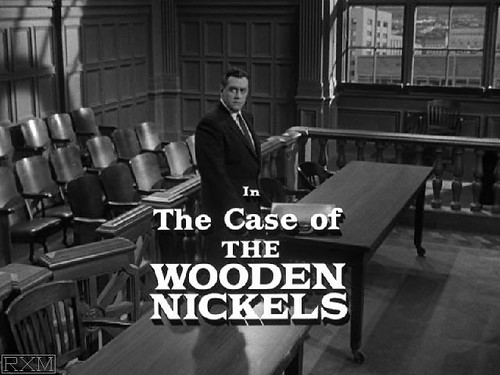 I recently saw a great numismatically-oriented Perry Mason episode: The Case of the Wooden Nickels.
Notwithstanding the title, the plot revolves around a collector who desperately wants to acquire one the four original Confederate Half dollars. He needs it to
go with his collection which includes a 1913 Liberty nickel, a 1796 Silver dollar, a gold fugio and an “1884 trade dollar with chop marks” Rare coins, but no
one handles them very carefully. One scene has Paul Drake standing on a street corner flipping and catching the Confederate half when a guy approaches and asks
if Paul would give him a half dollar so he could get something to eat. Spoiler alert: Paul gives him a buck.
I recently saw a great numismatically-oriented Perry Mason episode: The Case of the Wooden Nickels.
Notwithstanding the title, the plot revolves around a collector who desperately wants to acquire one the four original Confederate Half dollars. He needs it to
go with his collection which includes a 1913 Liberty nickel, a 1796 Silver dollar, a gold fugio and an “1884 trade dollar with chop marks” Rare coins, but no
one handles them very carefully. One scene has Paul Drake standing on a street corner flipping and catching the Confederate half when a guy approaches and asks
if Paul would give him a half dollar so he could get something to eat. Spoiler alert: Paul gives him a buck.


For our younger readers, Perry Mason was a TV show based on a series of novels about a crackerjack defense attorney. Like Law and Order, each show was a self-contained mystery story; Featuring Perry Mason, his assistant Della Street, and private detective Paul Drake, episodes typically ended in a big-reveal courtroom scene where the real killer blurts out a confession, exonerating Mason's client. This episode aired first in 1964. -Editor
For more information about the episode, see:
Perry Mason - The Case of the Wooden Nickels (1964)
(http://www.brianrxm.com/comdir/cnsmovtv_perrymason_nickels.htm)
#223: The Case of the Wooden Nickels Original Airdate: 12/10/64
(http://www.perrymasontvseries.com/wiki/index.php/EpisodePages/Show223)
To watch the episode, see:
8x12 The Case of the Wooden Nickels
(https://trakt.tv/shows/perry-mason/seasons/8/episodes/12)
QUERY: CEYLON BANKNOTE ESSAYS
Kavan Ratnatunga writes:
I am publishing for comments a webpage with a detailed discussion and links to about 150 Ceylon Banknote Essays obtained from the Spink lot archive. Please read and comment.
If anyone has any of the missing images or images of higher resolution please contribute to kavanr@gmail.com
Here's one note for illustration and a short excerpt from the page. Please help if you can. -Editor
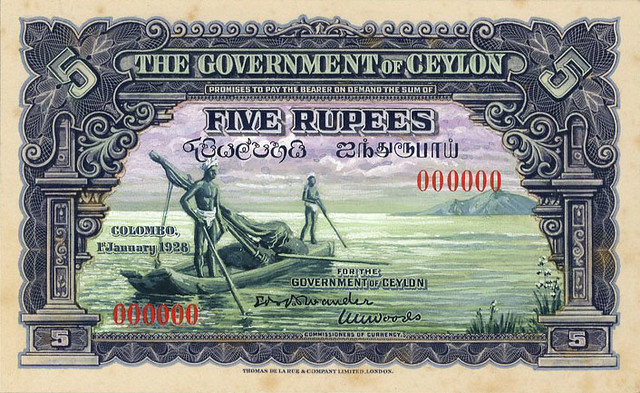
According to the International Bank Note Society (IBNS), An essay ("essai") or trial is any piece generated during the design phase, leading to the final banknotes. When compared with the final Banknote there might be significant variation and the essay may bear no resemblance to the final issue. 1 This study is focused and restricted to Ceylon banknotes designs which were never used to issue a banknote, and ignores color trials, color separations, specimens etc of issued notes.
An essay which is most often unique and therefore by definition extremely rare are popular among those collecting banknotes as an investment. Individually they didn't seem numismatically interesting, but as a collection, they tell an interesting background to the designs of banknote issue. Most are not properly cataloged and Auction Catalog Listings are the only source of information on essays. The Banknote essays sell for upward of £500.
Since around 2008 Spink of London has been listing a large number of Ceylon essays from the archives of Bradbury Wilkinson (BWCL) and Thomas De La Rue(TDLR). These essays got into the Numismatic market after TDLR took over BWCL in 1986. Spink has granted permission to use their images in this website, subject to the condition that a link is put to the original auction lot archive listing. This has been done to about 100 lots from 23 Auctions.
To read the complete web page, see:
Essays of Ceylon BankNotes 1927-1978 (http://notes.lakdiva.org/essay/)
VOCABULARY TERMS: BACKGROUND, INCUSE, DIAGLYPH
Dick Johnson submitted these entries from his Encyclopedia of Coin and Medal Terminology. Thanks. -Editor
Background. The elements of a numismatic or medallic design not in the foreground; the field. Coins and medals customarily have one or more devices which form the foreground design; with the exception of lettering and border, all else is the background. Background may – or may not – comprise additional design, called background texture with an infinite variety of texture, such as florentine, striated, mottled, pebbled surface. Or the background surface may be left completely blank (collectors call this clean field); or the background can be polished in the die to produce proof surface.
Since background recedes from the viewer, thus it is the lowest part of the struck design, it is the highest part of the die. As such, it is the first area for deterioration to occur in the stored die; if objects are dropped on it, or if moisture is present, this is the first area to rust. Thus dents or rust pits are most often found in the background, formed near the devices. Background is the same surface as field, ground, matrix and table, each term used by different professions in the creation and life of a coin or medal. See field.
Incuse.  Struck or stamped into a metal surface, as on a coin or medal. Incuse differs only slightly
from incise – incise means cut into any surface, incuse means stamped into a metal surface. A few coins bear incuse designs, the most notable is the U.S. $2
1/2 and $5 gold pieces (1908-1929) by Bela Lyon Pratt. Several ancient Greek coins bear incuse designs. A distinctive medal, the Society of Medalists Fortieth
Anniversary Medal, by Julian Hoke Harris, has a portion of its design incuse for contrast.
Struck or stamped into a metal surface, as on a coin or medal. Incuse differs only slightly
from incise – incise means cut into any surface, incuse means stamped into a metal surface. A few coins bear incuse designs, the most notable is the U.S. $2
1/2 and $5 gold pieces (1908-1929) by Bela Lyon Pratt. Several ancient Greek coins bear incuse designs. A distinctive medal, the Society of Medalists Fortieth
Anniversary Medal, by Julian Hoke Harris, has a portion of its design incuse for contrast.
Diaglyph.  An object with design below the background, with negative or intaglio relief. The design for the $5 and $2½ gold coins
(1908-1929) designed by Bela Lyon Pratt, is a numismatic diaglyph. It is the opposite of anaglyph, an object with raised or cameo relief. See relief,
anaglyphtography.
An object with design below the background, with negative or intaglio relief. The design for the $5 and $2½ gold coins
(1908-1929) designed by Bela Lyon Pratt, is a numismatic diaglyph. It is the opposite of anaglyph, an object with raised or cameo relief. See relief,
anaglyphtography.
I'd never heard of the "diaglyph" term before. Collectors typically call these "incuse". Dick's Encyclopedia covers a lot of ground, including many terms from the worlds of sculptors, engravers and die sinkers. -Editor
Looking for the meaning of a numismatic word, or the description of a term? Try the Newman Numismatic Portal's Numismatic Dictionary at: https://nnp.wustl.edu/library/dictionary
Or if you would like a printed copy of the complete Encyclopedia, it is available. There are 1,854 terms, on 678 pages, in The Encyclopedia of Coin and Medal Technology. Even running two a week would require more than 19 years to publish them all. If you would like an advance draft of this vital reference work it may be obtained from the author for your check of $50 sent postpaid. Dick Johnson, 139 Thompson Drive, Torrington, CT 06790.
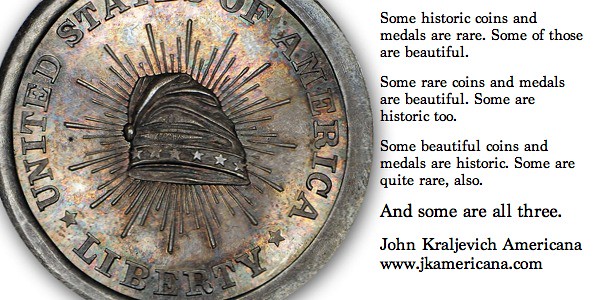
MORE ON CAMBISTS
A reader remarked:
I never heard the word "cambist" in my life.
Me neither, until I did. I learned the word "cambist" (and multiple unpublishable words and phrases) from my friend and poker-playing buddy John Burns, who in turn I'm sure learned "cambist" from reading the numismatic literature catalog descriptions of George Frederick Kolbe. George wasn't the first to deal in U.S. numismatic literature, but he was the first to take its cataloging to a new level of scholarship, just as John J. Ford had done with coin auction cataloging at New Netherlands in the 1950s.
Here's the Merriam-Webster definition. -Editor
1 : one who deals in bills of exchange or who is skilled in the science and practice of exchange
2 : a table or manual giving the exchange values of moneys, weights, and measures of various countries
To read the complete article, see:
cambist (https://www.merriam-webster.com/dictionary/cambist)
Here are the cambists on the Newman Numismatic Portal. There must be more - would anyone have a list of cambists published in the U.S.? -Editor
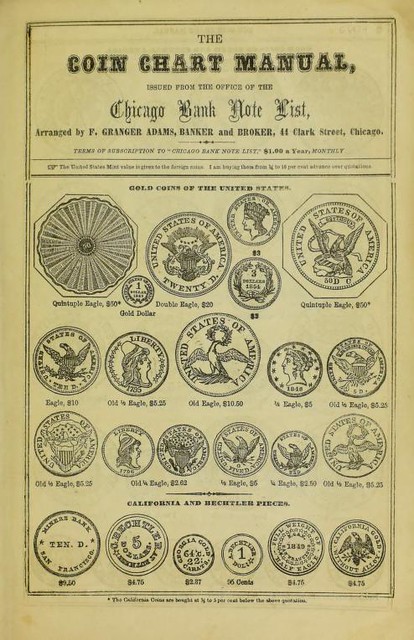 Coin Chart Manual [F. Granger Adams]
Coin Chart Manual [F. Granger Adams]
The Coin Chart Manual [J. Thompson]
The Coin Chart Manual [Scott]
Coin Supplement to Gwynne and Day's Bank Note Register and Detector of Counterfeits
Coins of the World [Imlay & Bicknell]
Dye's Gold and Silver Coin Chart Manual
Hodges' Gold and Silver Coin Chart Manual
Johnson's Coins of the World: A supplement to Lord's Detector
Lawrence & Co.'s Book of Coins
Paddock's Gold and Silver Coin Chart Manual
To read the earlier E-Sylum article, see:
NEWMAN PORTAL PERIODICAL TAGS UPDATED
(https://www.coinbooks.org/v22/esylum_v22n29a09.html)
SAMUEL CHARLES BUSHNELL (1887-1957)
 Samuel Charles Bushnell (1887-1957), was born on August 17, 1887, at Peoria, Illinois, son of William M.
Bushnell (1864-), a general freight agent for the railroads, and Laura Smith Bushnell (1866-1948).
Samuel Charles Bushnell (1887-1957), was born on August 17, 1887, at Peoria, Illinois, son of William M.
Bushnell (1864-), a general freight agent for the railroads, and Laura Smith Bushnell (1866-1948).
Blue eyed Sam Bushnell was a 6'-2" weighing 190 lbs., and followed in his father's footsteps becoming a general agent for the railroads. He collected stamps, coins and paper money, especially old mail of the Gold Rush Era, and broken bank bills. He was very active in Missouri numismatics and a friend of Eric P. Newman. Both were active in several numismatic circles and societies together.
The 1900 U.S. Census lists Bushnell living with his parents at 4235 McRee Avenue, St. Louis, Missouri.
In 1903, he joined the Chicago, Peoria & St. Louis Railroad.
In February 1907, he ran an advertisement as a paper money collector soliciting old broken notes and CA paper money when he was living at Oak Park, Illinois, in the Philatelic West, Vol. 35, No. 2, February (1907)
In 1907, Bushnell became a buyer U. S. paper money from Burdette G. Johnson, St. Louis Stamp & Coin Company. This is gleaned in "A Tribute to the Late Burdette G. Johnson," The Numismatist, June (1947) : 421-422. Both Carl W. Lounsberry and Bushnell were friends for forty years and school chums growing up together.
On February 26, 1908, he married Gertrude May Waggoner Barnes (1886-1977), daughter of Samuel Barnes and Jennie A. Waggoner Barnes. They had children : Wilbur Samuel Bushnell (1909-1993), Frances M (1919-), Richard B (1915-), Charles Hunt Bushnell (1922-2007), and William Everett Bushnell (1926-). Gertrude Bushnell was also an avid stamp collector with her husband.
In 1938, he was chairman of the St. Louis Numismatic Society exhibition committee.
In June 1939, he exhibited his collection of U. S. paper money, fractional currency, especially Missouri State bills at the St. Louis Numismatic Society and also at the Missouri Numismatic Society.
On June 10, 1940, he was unanimously elected president of the Missouri Numismatic Society.
On April 26, 1942, he registered for the draft during WWII.
Bushnell was an aerophilatelist, i.e., he collected covers sent via air mail service and prized the postage and post-markings. He was also a member of the American Air Mail Society since 1933.
In October 1953 he was listed in The Numismatist as a donor to the ANA Library.
The 1955 Centennial of the St. Charles, Missouri Post Office was researched by Bushnell having its origin in St. Peters on December 31, 1855.
He died on August 25th, 1957, 8 days after his 70th birthday, at St. Joseph's Hospital, St. Charles, Missouri.
To read the complete article, see:
BUSHNELL, SAMUEL CHARLES
(https://sites.google.com/a/numismaticmall.com/www/numismaticmall-com/bushnell-samuel-charles)
The entire inventory of the Lupia Numismatic Library is for sale. Individual items will be available before the remaining archives are broken up into parcels sold at philatelic auctions in the U. S. and Hong Kong. Check NumismaticMall.com frequently as dozens of new items with estimates will be posted daily until everything is sold.
All inquiries will be given prompt and courteous attention. Write to: john@numismaticmall.com .
HARVEY STACK'S NUMISMATIC FAMILY, PART 49
The latest article in Harvey Stack's blog series focuses on collector R.L. Miles, Jr., with a great story about an exhibit of his coins in Virginia. Here is part 489 Thanks, Harvey. -Editor
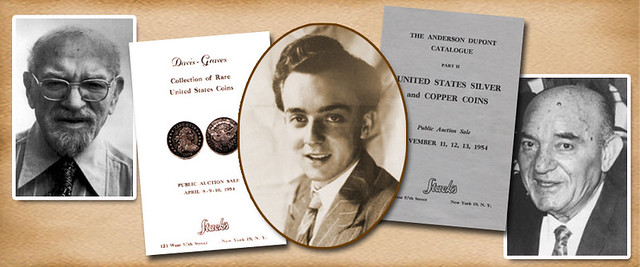
R.L. Miles, Jr. (Skinny as I called him) became a collector when he was employed by his family at the J.H. Miles Oyster Co. in Norfolk, Virginia. The Miles family harvested oysters from Chesapeake Bay for over 150 years. The company had "shuckers" on site, occupying as many as 1,000 sinks, where these workers opened and prepared the oysters for shipping. They were packed in ice to be shipped as far as the available transportation allowed.
In the very early days, when Skinny was still a teenager, he was in the cashier's office and worked with that department in preparing pay envelopes for each employee. While handling the change he became interested in seeing how many different dates and mints he could accumulate.
He loved the Barber design half dollar and acquired many in duplicate. He became aware that the years 1914 and 1915 were scarcer than many others, and he started accumulating those dates. Eventually he bought only Proof or Mint State examples, amassing several hundred of each; to him the fun was in getting more than anyone else, not necessarily making a profit.
Skinny then became interested in many other coinage series and acquired various pages, boards and albums to seek out coins from circulation. From this beginning he developed into a dedicated numismatist. He read about the famous Eliasberg Collection, which was often on display in banks in the Baltimore area, and he went to view the exhibits when he could. He was impressed that Eliasberg had "all the holes filled" and he set for himself a goal of trying to match that collection. He started buying choice examples as well as rare and extremely rare coins. Skinny would come to New York often. He would buy from the Stack's inventory and attend sales and bid for coins there. He also enjoyed playing bridge. He and his partner each had high master points and they played in competitions nationwide. Sometimes these bridge matches conflicted with our auction schedule, and Stack's was entrusted with his bids. We developed a real friendship and he depended on Stack's to examine coins for his vast and growing collection.
A strange thing happened in Norfolk that attracted Skinny's personal interest. As a naval city, Norfolk was always crowded with naval personnel, shipbuilders and suppliers. During World War II it became somewhat rundown, especially near the vast waterfronts. The city, with help from the banks, decided to try to revive the harbor area and engaged in a large project to rebuild this part of town.
In the early 1960s two major banks in Norfolk were the Virginia National Bank (of which R.L. Miles, Jr. was a director) and the Bank of Virginia (which Henry C. Gibson, another coin collector and president of Norfolk Shipbuilding was associated with). Both banks decided to locate their new headquarters in the revived section of Norfolk, to attract more upbeat businesses to that area. It was customary in the 1960s for banks to have in their main offices a museum to attract visitors and contribute to the education of its citizens. Both Miles and Gibson promised to display their coin collections (on loan) as highlights of the bank openings.
In mid 1967 Skinny came to me with the news that since he had virtually completed his collection (only the most extreme rarities were not included) he would consider selling the coins while he was still alive. Once he had fulfilled the obligation of the bank display, he was ready to watch others experience the pleasure of ownership that he had always known.
In fall 1967, the Middle Atlantic States Numismatic Convention was convened in Norfolk, at Fort Myers, a government site used also as a hotel and exhibition place. I went there with my wife to meet local collectors and dealers, and of course to see Skinny. He attended the first day, looked around and was disappointed in the displays. No rarities were shown; no serious collections were on exhibit. Skinny asked if he could pick me up the next morning and take me to his bank where we could pick out some exciting coins from his display there to create a noteworthy exhibit at the show.
So the next morning, he picked me up and we went to the bank and there, in large vaults was his collection. Each series was in large black plastic holders, custom made so he could enjoy each series without damaging the coins or getting finger prints on them. He considered especially important the holders that featured the early issues in each series. Even in 1967 there was a lot of value in these sets. Off we went to the convention, where we put the holders and coins out and from that moment on we had a super display. Collectors and other dealers were impressed by these coins and it gave Stack's the opportunity to let people know that the items would soon be offered by us at public auction.
Skinny said he would pick up the coins and me on Saturday morning and take the coins back to the bank and me to my hotel so I could make my flight home. When Saturday morning rolled around, Skinny had not arrived by noon so I called his wife. She told me that he had been in an all-night bridge match (which he won) and had overslept. We both realized that we did not have time to get the coins back to the bank and for me to make my flight. Instead, he suggested that I take the coins with me and keep them at Stack's, and then either ship or bring them back for the bank opening in late December. I had to think quickly. What if something happened on the way home? Was I fully insured? I had to make a decision. I got some extra satchels from the hotel and asked a friend to travel with my wife, myself and Skinny's coins. We got home safely and Norman, who I had contacted before leaving Virginia, met us at LaGuardia Airport and took my wife and me along with the coins into the city to the shop. It was a great relief when we locked the coins in the large vault and went home happy but exhausted.
To read the complete article, see:
Harvey Stack Remembers:: Growing Up in a Numismatic Family
Part 49 (https://www.stacksbowers.com/News/Pages/Blogs.aspx?ArticleID=harvey-stack-remembers-49)
To read the earlier E-Sylum article, see:
HARVEY STACK'S NUMISMATIC FAMILY, PART 48
(https://www.coinbooks.org/v22/esylum_v22n28a14.html)
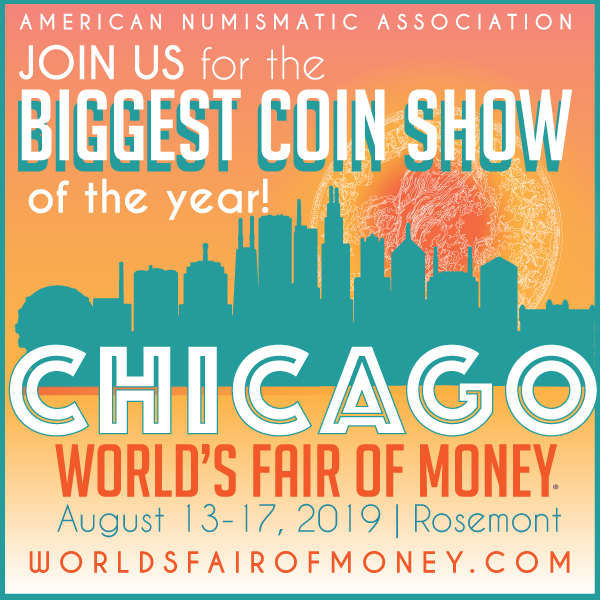
FRANKLIN’S LIBERTAS AMERICANA MEDAL EXHIBIT
Stack’s Bowers Galleries is preparing an exhibit on the Libertas Americana Medal for the upcoming ANA convention. Here's the press release. -Editor
At the upcoming American Numismatic Association’s World’s Fair of Money Convention in Rosemont, Illinois, August 13-18, Stack’s Bowers Galleries is pleased to announce it will have at their bourse table 1005 an incredible display assembled by the Cardinal Collection Educational Foundation and centered around one of the most beautiful and important medals struck in American history.
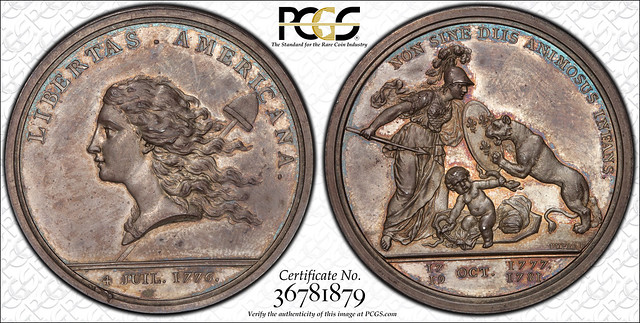
1783 Libertas Americana Medal in Silver
Following decisive victories at Saratoga and Yorktown, Benjamin Franklin wrote to the United States Secretary of Foreign Affairs Robert Livingston: "This puts me in mind of a medal I have had a mind to strike ... representing the United States by the figure of an infant Hercules in his cradle, strangling the two serpents; and France by that of Minerva, sitting by as his nurse, with her spear and helmet, and her robe specked by a few 'fleurs-de-lis.'" From concept to realization, execution, delivery, payment, and worldwide press coverage, Benjamin Franklin truly was THE man behind the historic Libertas Americana medals. He leveraged his position in France as the Minister Plenipotentiary representing the United States to garner support and connect with preeminent artists and engravers of the day. He personally stewarded the process to bring the Medals into reality. The manifestation of Benjamin Franklin's vision of Liberty -- the beautiful Libertas Americana Medal made in 1783 – struck a chord with the people and nations of the world, and ultimately became the inspiration for the Flowing Hair Liberty coinage of the First United States Mint.

1795 Flowing Hair Dollar
From the very beginning, the Flowing Hair portrait of Lady Liberty was described as a "fine woman" and a "beautiful maiden." The lovely image of Lady Liberty inspired artists and engravers of the day, and became the genesis of the Flowing Hair and Liberty Cap coinage of the First United States Mint. Yet, the inspiration provided by Liberty did not end there, but has continued on through generation after generation, enduring in the minds of the public and spawning official restrikes and tribute pieces through to the present day. Not surprisingly, it was the unanimous choice for the Number 1 spot among the 100 Greatest American Medals and Tokens. While the original medals of 1783 may be challenging to acquire (especially those struck in silver), a series of later restrikes have been issued officially in a variety of metals and formats, allowing this beautiful and historic design to be within the reach of collectors everywhere.

1795 Liberty Cap Cent
The Cardinal Collection Educational Foundation’s Tribute to the Libertas Americana medals includes examples of the original silver and bronze medals distributed by Benjamin Franklin himself, and examples of the Flowing Hair/Liberty Cap coinage the medal inspired. Also included are Paris Mint official emissions of so-called “restrikes” (struck from newly engraved dies copied directly from the original dies), as well as period ephemera such as Benjamin Franklin’s “Explication” of the Libertas Americana medal” (perhaps the only copy in private hands), a rare original plate from the 1784 book Historisch-Genealogischer Calender oder Jahrbuch der merkwurdigsten neuen Welt Begebenheiten fur 1784, by C. M.Sprengel, and an original etching of George Washington on horseback with an etching of the Libertas Americana medal beneath.
We invite those planning to attend this year’s ANA World’ Fair of Money convention to take the time to admire and study this remarkable display.
DIX NOONAN WEBB RUSSIAN SALE SEPTEMBER 17, 2019
Dix Noonan Webb will be holding their first sale of Russian coins and medals on September 17, 2019. Here's the press release. -Editor
Dix Noonan Webb, the international coins, medals, banknotes and jewellery specialists will be holding their first auction devoted to Russian Coins and Historical Medals. The auction will be held on Tuesday, September 17, 2019 at 2pm at their auction rooms in central Mayfair - 16 Bolton St, London, W1J 8BQ.

The most important part of the sale is an old collection of Russian historical medals, mostly formed in the 1960s and 1970s. Three highlights from this collection include an extremely fine and very rare silver medal from the reign of Tsar Peter the Great (1682-1725), dating from 1704 and commemorating the Capture of Narva, by I. Konstantinov. The medal, estimated at £3,000-4,000, portrays a uniformed laureate bust of Peter I on one side and a view of the bombardment of Narva on the other.

An extremely fine and very rare silver medal depicting the Coronation of Catherine the Great (1762-96) from 1762, by T. Ivanov and G.C. Waechter, showing a crowned bust of the Empress on one side and Russia and Faith standing at an altar, with Providence in the cloud above holding a crown and sceptre, on the other, is expected to fetch £3,000-£4,000.

Also of note is an extremely fine and extremely rare silver medal of Catherine the Great (1762- 96), dating from 1771 by G.C. and J.G. Waechter. On one side of the medal is a portrait of the Empress, who was the country's longest-ruling female leader, while the other side shows Count Grigory Grigorievich Orlov on horseback with a view of Moscow in the background. Count Orlov led the coup which overthrew Catherine's husband Peter III and installed Catherine as empress. This medal is estimated at £9,000-£12,000.
 The sale also contains nearly two hundred lots of coins, including a good selection of the
medieval coins commonly known as ‘wire money’, and historical medals from other properties.
The sale also contains nearly two hundred lots of coins, including a good selection of the
medieval coins commonly known as ‘wire money’, and historical medals from other properties.
Tim Wilkes, Specialist in Charge, Coin Department, Dix Noonan Webb, commented: “We are very pleased to be holding our first auction devoted to Russian Coins and Medals dating from the 14th century to the 21st century. The coins and medals depict many of the significant figures and key historic moments in Russian history.”
For more information, see:
https://www.dnw.co.uk/
ALAN V, WEINBERG PART II SELECTIONS
Here's a selection of items I came across in the Heritage sale of the Alan V, Weinberg Collection, Part II. -Editor
Lot 3316: Oak Tree Threepence


1652 3PENCE Oak Tree Threepence, IN on Obverse, AU53 PCGS. Noe-23, W-260, Salmon 1-A, R.6. 18.0 grains. Die Alignment: 0°. Christopher Salmon enumerates nine die varieties of the Oak Tree threepence that were struck from seven obverse dies and two reverse dies, the latter re-engraved more than once for Noe-24 to 27. Salmon's obverse 1 is lettered IN MASATHVSETS with each S backward. This is the only obverse die with the word IN, and for that reason it is an important variety for type collectors.
The plate coin for W-260 in the Whitman Colonial Encyclopedia, this piece is finer than two of the three Ford coins, and clearly finer than the Salmon plate coin. This is only the fourth example that we have offered during the past quarter-century.
A great rarity, indeed. Super coin. -Editor
To read the complete lot description, see:
1652 3PENCE Oak
Tree Threepence, IN on Obverse, AU53 PCGS. Noe-23, W-260, Salmon 1-A, R.6....
(https://coins.ha.com/itm/colonials/1652-3pence-oak-tree-threepence-in-on-obverse-au53-pcgs-noe-23-w-260-salmon-1-a-r6/a/1298-3616.s)
Lot 3819: 1893 Columbian Exposition Gold Medal
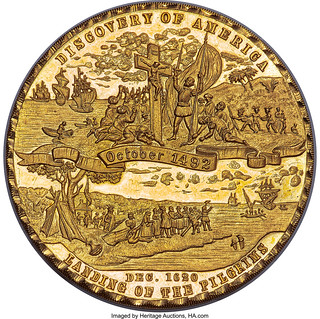
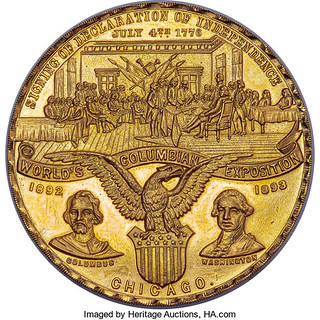
1893 Columbian Exposition Gold Medal, Eglit-36A, Similar to HK-156 and HK-157, MS63 Prooflike NGC. 171.0 grams, 58.7 mm. Reeded Edge. Maier Weinschenk (1834-1905) and William Boldenweck (1851-1922), both of Chicago, submitted design patents 20,195 and 20,196 for the obverse and reverse designs of this medal, and both were approved on October 7, 1890 for a term of 3.5 years. The original patents including drawings of the two "faces" of the medal, described in detail in the patents. From patent 20,195:
"The drawing represents a front view of the design and illustrates two cardinal events in the history of America. The upper portion of the drawing represents the first cardinal event, viz: the discovery of America by Columbus. The lower portion of the drawing represents the second cardinal event, viz: the landing of the Pilgrims at Plymouth."
And from patent 20,196:
"The drawing represents a front view of the design. The upper portion consists of a pictorial representation of the signing of the Declaration of Independence. Immediately below this picture is a scroll extending across the face of the medal. Occupying the lower central portion of the design and partly overlapping the scroll and picture described above is an eagle surmounting a shield, and at each side of the shield and eagle is a portrait, as shown."
These important medals that tell the history of America from the discovery of Christopher Columbus, to the landing of the Pilgrims, and the signing of the Declaration of Independence. A large and heavy gold medal, the design is unique in that composition, while others are known in copper or bronze, white metal, and aluminum. The Chicago firm, Boldenweck and Company, produced these medals in two sizes, 37 mm. and 58 mm.
Alan V. Weinberg comments: Ex Israel Switt - the original owner of the ten 1933 double eagles, and found in the back of his Philadelphia safe. An utterly extraordinary, high-quality, heavy yellow gold (apparently 23 karat) medal that was apparently hand-finished by a Chicago jeweler who hand-scalloped the rims and finely reeded the edge. Absolutely unique with but one single auction record (Bowers & Merena) and previously unknown. One of the most impressive late 19th century medals I've ever seen.
A rather busy medal design, but very impressive nonetheless. I've never seen one of these. And where else can you get a gold piece pedigreed to Izzy Switt? -Editor
To read the complete lot description, see:
1893
Columbian Exposition Gold Medal, Eglit-36A, Similar to HK-156 and HK-157, MS63 Prooflike NGC. ...
(https://coins.ha.com/itm/expositions-and-fairs/1893-columbian-exposition-gold-medal-eglit-36a-similar-to-hk-156-and-hk-157-ms63-prooflike-ngc/a/1298-3819.s)
Lot 4439: 1790 Washington Manly Medal
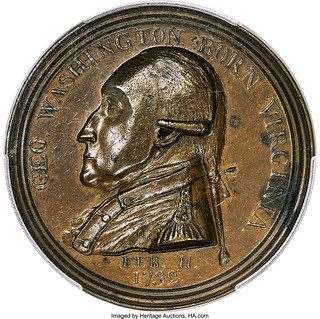
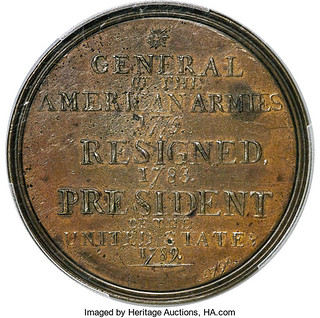
1790 Washington Manly Medal, Baker-61B, Musante GW-10, First Obverse, Bronze, MS61 Brown PCGS. This famous medal is recorded as number 17 in the 100 Greatest American Medals and Tokens by Katherine Jaeger and Q. David Bowers. They estimate that 150 to 250 of these medals are known in bronze, although few are as fine as the present example. A small number of these medals were also produced in white metal, silver, and gold.
The obverse die is signed BROOKS F. on the bust truncation, while the reverse die has J. MANLY & C. 1790 inside the lower border, although Manly's name has been carefully removed from this particular example, as it has from several bronze, white metal, and silver pieces. Perhaps those that Peter Rynberg of Wilmington, Delaware sold are the pieces with Manly's name removed, or they may have been examples that Manly sold wholesale to other individuals. It is almost certain that Manly's name was removed at the time these medals were issued.
Not a beautiful medal by any stretch, but early, rare and important. -Editor
To read the complete lot description, see:
1790
Washington Manly Medal, Baker-61B, Musante GW-10, First Obverse, Bronze, MS61 Brown PCGS
(https://coins.ha.com/itm/washingtonia/1790-washington-manly-medal-baker-61b-musante-gw-10-first-obverse-bronze-ms61-brown-pcgs/a/1298-4439.s)
Lot 4442: 1857 Royal Hawaiian Agricultural Society Medal
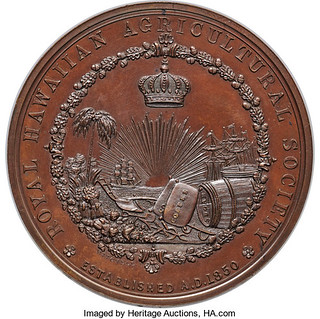

Circa 1857 Royal Hawaiian Agricultural Society Medal, Julian AM-24, Medcalf 2RM-5, Harkness HI-30. MS66 Brown NGC. Bronze, 149.4 grams, 64 mm. The obverse has a wreath enclosing the Royal Hawaiian crown and various symbols and implements of Hawaiian agriculture including cotton, sugar, a plow, two ships, and the sun and rays on the ocean horizon, with ROYAL HAWAIIAN AGRICULTURAL SOCIETY / ESTABLISHED A.D. 1850 around, and is signed by Mitchell. The reverse has a wreath enclosing a blank space with the legend PREMIUM FOR THE BEST EXHIBITED. This pristine walnut-brown medal is unawarded. Listed on page 152 of the second (1991) edition of Hawaiian Money Standard Catalog by Donald Medcalf and Ronald Russell. Julian reports that these medals were ordered in 1854, and struck through 1857. They are doubtless extremely rare. This boldly defined representative has lovely mahogany-brown surfaces with no spots or other imperfections.
Francis Nalder Mitchell was a distinguished middle-19th century medalist, engraver, and die sinker who worked in Boston in the 1840s to the 1850s. He was born in Edinburgh, Scotland in 1810, and died in Scotland in 1865, having returned there a few years earlier. Among medals attributed to Mitchell are 18 different entries in the Julian reference. Mitchell engraved the award medals for the Massachusetts Charitable Mechanic Association (AM-34 through AM-41). He was selected for a die sinking award in 1850 and received the medal that he had designed.
Great medal. I've never seen one of these before, either. -Editor
To read the complete lot description, see:
Circa 1857 Royal Hawaiian Agricultural Society Medal, Julian AM-24, Medcalf 2RM-5, Harkness HI-30. MS66 Brown NGC
(https://coins.ha.com/itm/u.s.-mint-medals/circa-1857-royal-hawaiian-agricultural-society-medal-julian-am-24-medcalf-2rm-5-harkness-hi-30-ms66-brown-ngc/a/1298-4442.s)
Lot 4457: 1883 National Exposition of Railway Appliances Medal
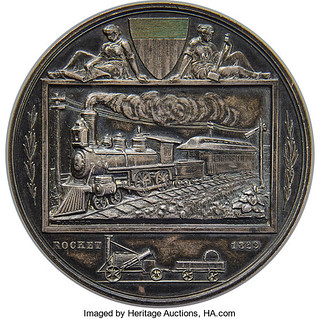
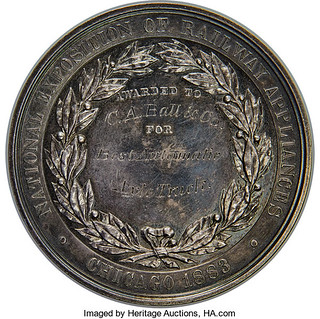
1883 National Exposition of Railway Appliances, Chicago, Silver Medal, Harkness Nat-220, MS63 NGC. 98.8 grams, 58 mm. Awarded to C.A. Ball & Co. for the best automatic axle truck. An axle truck is the assembly that includes two axles and four wheels with two axle trucks supporting each rail car. This medal is unlisted in Julian, despite being signed on the obverse by both Barber and Morgan. If it was not struck at the Mint, it would be an extremely unusual collaboration between the two engravers.
These medals are doubtless extremely rare, especially when awarded as offered here. This is the first the cataloger recalls handling in any composition, and it is the first that Heritage has handled. Original records from the Exposition indicate that more silver medals were prepared than bronze or gold, although few survive. It may be the case that only a few were awarded.
Great work, and double the size of a silver dollar! What's not to like about a big choo-choo medal? -Editor
To read the complete lot description, see:
1883 National Exposition of Railway Appliances, Chicago, Silver Medal, Harkness Nat-220, MS63 NGC. ...
(https://coins.ha.com/itm/expositions-and-fairs/tokens-and-medals/1883-national-exposition-of-railway-appliances-chicago-silver-medal-harkness-nat-220-ms63-ngc/a/1298-4457.s)

THE OAK RIDGE DIME IRRADIATOR
Joe Esposito writes:I came across this article recently while looking up information related to the Trinity explosion in New Mexico, which took place seventy-four years ago.
Thanks! It's from the site of Oak Ridge Associated Universities, home of the Oak Ridge reactor where souvenir irradiated dimes were produced. Here's an excerpt, but be sure to read the complete version online. -Editor
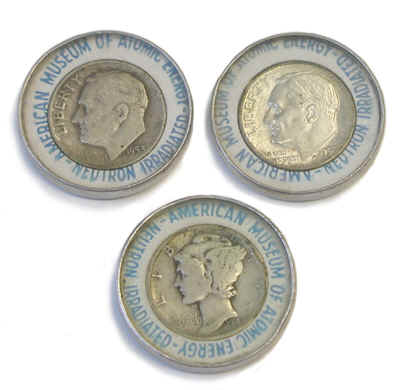 During the 1950s, the Oak Ridge
Graphite Reactor was the world’s single largest source of radionuclides, and the availability of these radionuclides revolutionized the field of medicine and
many branches of science. The impact was no less great in the industrial sector. Radionuclides were produced in several ways, but neutron activation was
perhaps the most important. The purpose of the dime irradiator at the American Museum of Atomic Energy, located in Oak Ridge, Tennessee, was to provide a
dramatic demonstration of the principle of neutron activation. Today, the museum is known as the American Museum of Science and Energy.
During the 1950s, the Oak Ridge
Graphite Reactor was the world’s single largest source of radionuclides, and the availability of these radionuclides revolutionized the field of medicine and
many branches of science. The impact was no less great in the industrial sector. Radionuclides were produced in several ways, but neutron activation was
perhaps the most important. The purpose of the dime irradiator at the American Museum of Atomic Energy, located in Oak Ridge, Tennessee, was to provide a
dramatic demonstration of the principle of neutron activation. Today, the museum is known as the American Museum of Science and Energy.
At the time that the dime irradiator was in operation, the Museum was managed by the Oak Ridge Institute for Nuclear Studies (ORINS). ORINS is now Oak Ridge Associated Universities (ORAU).
In the late 1940s and/or early 1950s, dimes were irradiated at Oak Ridge National Laboratory (ORNL) and encased in a similar fashion (see photo below left).
Encased dimes were also produced at atomic energy exhibits conducted at one or more Mid-South Fairs during the 1950s and early 1960s (see photo below right). At least one such fair was in Memphis.
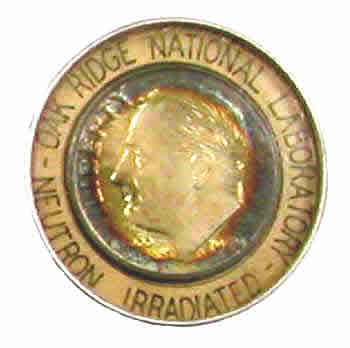

The following description is from what I believe was a 1954 press release from the American Museum of Atomic Energy:
"One of the most popular exhibits in the American Museum of Atomic Energy is a "dime irradiator." To date, more than 250,000 dimes have been irradiated, encased in plastic and returned to their owners as souvenirs. The irradiator works as follows: A mixture of radioactive antimony and beryllium is enclosed in a lead container. Gamma rays from the antimony are absorbed by the beryllium atoms and a neutron is expelled by the beryllium atom in the process.
These neutrons, having no electrical charge, penetrate silver atoms in the dime. Instead of remaining normal silver-109, they become radioactive silver-110. After irradiation, the dime is dropped out through a slot in the lead container and rests momentarily before a Geiger tube so that its radioactivity may be demonstrated. It is then encased in the souvenir container. Radioactive silver, with a half-life of 22 seconds, decays rapidly to cadmium-110 (In 22 seconds, half of the radioactivity in each dime is gone, in another 22 seconds half the remainder goes, and so on until all the silver-110 has become cadmium). Only an exceedingly minute fraction of the silver atoms have been made radioactive."
It seems that sometime in the 1960s, the museum and ORINS personnel decided to switch from the plutonium-beryllium neutron source to an americium-beryllium source. This required a trip to the Atomic Energy Commission (AEC) in Washington to secure approval and make the necessary arrangements. While the meeting was underway, Glenn Seaborg happened to drop in to see what was going on. Seaborg was both the discoverer of plutonium and the Chairman of the AEC, so when he made a casual comment to the effect that he assumed that they were using a plutonium source, any thought of an americium-beryllium source was scrubbed and the Oak Ridge contingent went back home. The solution was to increase the activity of the plutonium.
I am not certain about the exact dates that the dime irradiator operated, but one report suggests that it was between 1949 and 1967. By then something like 1 million dimes had been irradiated. The end of the program was brought about in 1964 when they stopped using silver in U.S. coins, at least the small denomination coins. In 1965, they started making the dimes out of nickel clad copper. For a time, the Museum purchased rolls of dimes from the local banks and separated out the silver containing dimes in an effort to keep the program going.
A dime irradiator occasionally took to the road. For example, one of these was set up at the 1964 World's Fair in New York. Visitors to the World's Fair exhibit who irradiated their dimes were given a blue plastic carrier with an atomic logo on it to hold them (photos below). Since the carriers were not sealed, there is no certainty that a dime they hold today had ever been irradiated.


At some point, the blue plastic holders were also used at the museum itself - see the images below. Perhaps the switch was made from the aluminium case sometime around 1964?

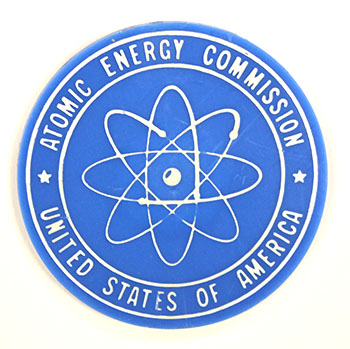
There is at least one other version of an irradiated dime (aluminum encased similar those at the top of the page) that is not in the ORAU collection. The text on it reads as follows:
"ORNL - UCNC - Oak Ridge - Neutron Irradiated" (UCNC refers to Union Carbide Nuclear Company)
I'm always excited to see articles from outside the numismatic community; these often provide original source material to document numismatic objects such as these encased dimes. This article does however reference a 1999 Coin World article by our own frequent contributor Mike Marotta, making it at least somewhat derivative. But I checked with Mike and he said his article was based on two visits to Oak Ridge, so this is likely quite accurate. -Editor
To read the complete article, see:
Irradiated Dimes -
(1950s, 1960s) (https://www.orau.org/ptp/collection/medalsmementoes/dimes.htm?fbclid=IwAR0258gh0asbiKx6FyguzZECVlxY9rVHnidIPeDizfNwxqfE4foF9ERcQ4I)
1879 ANGLO-ZULU WAR VICTORIA CROSS EXHIBIT
The Regimental Museum of The Royal Welsh in Brecon, Wales has mounted an exhibit of all eight Victoria Cross medals awarded in the 1879 Anglo-Zulu War. -Editor

The British Army has put iconic medals from one of the most famous battles in its history - the Battle of Rorke's Drift - on display for the first time.
Today, July 22, is the 140th anniversary of the siege that inspired the classic Michael Caine movie, Zulu.
In 1879, 150 British and colonial troops successfully defended a trading post under attack from between 3,000 and 4,000 Zulu warriors.
Now, on the 140th anniversary of the Battle of Rorke's Drift, the British Army has welcomed the leader of the Zulu Nation - and put all eight Victoria Cross Medals awarded to The Royal Welsh regiment on display for the first time.
A British Army spokesperson said: "They have been unlocked from their secure vault to be exhibited for the first time to coincide with this week's Wales visit of the Zulu King in tandem with this year's 140th anniversary of the Battle of Rorke’s Drift.
Some of them have been displayed before, but not all eight at once.
To read the complete article, see:
British Army shows iconic medals from most famous battle for
the first time (https://www.cornwalllive.com/news/uk-world-news/british-army-shows-iconic-medals-3122867)
For more information on the Regimental Museum, see:
The Regimental Museum of The Royal Welsh (Brecon)
(http://royalwelsh.org.uk/regimental-museum-of-the-royal-welsh.shtml)
SAFE DEPOSIT BOXES AREN'T SAFE
Len Augsburger forwarded this cautionary story about safe deposit boxes from the New York Times. Here's an excerpt - see the complete article online. Thanks. -Editor
In the early 1980s, when Philip Poniz moved to New Jersey from Colorado, he needed a well-protected place to stash his collection of rare watches. He had been gathering unusual pieces since he was a teenager in 1960s Poland, fascinated by their intricate mechanics. His hobby became his profession, and by the time of his relocation, Mr. Poniz was an internationally known expert in the history and restoration of high-end timepieces.
At first, he kept his personal collection in his house, but as it grew, he wanted something more secure. The vault at his neighborhood bank seemed ideal. In 1983, he signed a one-page lease agreement with First National State Bank of Edison in Highland Park, N.J., for a safe deposit box.
Over the next few decades, the bank — a squat brick building on a low-rise suburban street — changed hands many times. First National became First Union, which was sold to Wachovia, which was then bought by Wells Fargo. But its vault remained the same. A foot-thick steel door sheltered cabinets filled with hundreds of stacked metal boxes, each protected by two keys. The bank kept one; the customer held the other. Both were required to open a box.
In 1998, Mr. Poniz rented several additional boxes, and stored in them various items related to his work. He separated a batch of personal effects — photographs, coins he had inherited from his grandfather, dozens of watches — into a box labeled 105. Every time he opened it, he saw the glinting accumulation of his life’s work.
Then, on April 7, 2014, he lifted the thin metal lid. Box 105 was empty.
With banks on a branch-closing binge, there are fewer and fewer safe deposit boxes available for storing numismatic collections. What are the alternatives? Will storage companies get into the market with some form of controlled-access storage for valuables? At least long-term storage is their core business. There are secure warehouses for artworks, so why not for numismatics? -Editor
To read the complete article, see:
Safe Deposit Boxes Aren't Safe
(https://www.nytimes.com/2019/07/19/business/safe-deposit-box-theft.html)
LOOSE CHANGE: JULY 28, 2019
Here are some additional items in the media this week that may be of interest. -Editor
Great Synagogue of Vilna Coin Find
Arthur Shippee passed along this story from The Jerusalem Post about a find of coins from the 16th to 20th centuries in the ruins of a destroyed synagogue (scroll to end). -Editor
 For the first time since the beginning of the excavation project of the Great Synagogue of Vilna,
which was burned down in the Holocaust and destroyed by the Soviets, Hebrew inscriptions were discovered there from 200 years ago.
For the first time since the beginning of the excavation project of the Great Synagogue of Vilna,
which was burned down in the Holocaust and destroyed by the Soviets, Hebrew inscriptions were discovered there from 200 years ago.
According to the researchers, Dr. Jon Seligman of the Israel Antiquities Authority and Justinas Racas of the Lithuanian Excavation Company who have conducted excavations in Lithuania every summer for the last four years, "the large and significant inscription, dated to 1796, was part of a stone Torah reading table that stood on the magnificent bimah of the synagogue in Vilnius."
"Below the Bimah, and also unknown to the researchers was a large cellar. Among the finds recovered during the excavation were a prayer book that survived the Holocaust, hundreds of coins from the 16th to 20th centuries and buttons of Napoleon's army, which passed through Vilnius on its way to defeat in Moscow in 1812.
To read the complete article, see:
Archaeologists find inscriptions in
destroyed Vilna synagogue - watch (https://m.jpost.com/Diaspora/Hebrew-inscriptions-found-in-Vilna-Great-Synagogue-from-200-years-ago-596542)
Five Favorite Numismatic Reads
In an article on the PCGS site, Mike Sherman discusses some favorite numismatic books. Good choices! -Editor
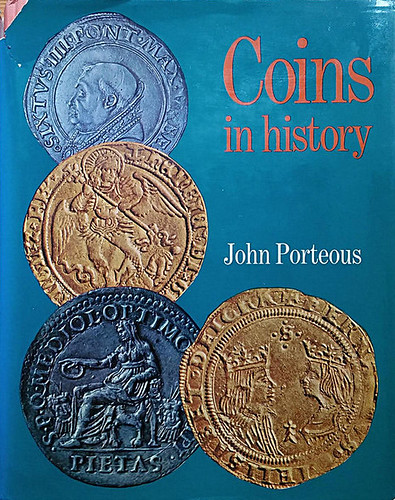 At the outset, it should be clear
that this is a highly personalized list. It's not a list of the most important or influential books in numismatics. The venerable Redbook would probably
top that list. It's simply a list of some of the coin books I've enjoyed for many years, and never tire of occasionally picking up and browsing again.
For the most part, they are generalist works as my interests lie in the broader picture of numismatics as opposed to the specific. So, with that, here are a
few of my all-time favorites.
At the outset, it should be clear
that this is a highly personalized list. It's not a list of the most important or influential books in numismatics. The venerable Redbook would probably
top that list. It's simply a list of some of the coin books I've enjoyed for many years, and never tire of occasionally picking up and browsing again.
For the most part, they are generalist works as my interests lie in the broader picture of numismatics as opposed to the specific. So, with that, here are a
few of my all-time favorites.
To read the complete article, see:
My Five Favorite Numismatic Reads
(https://www.pcgs.com/news/my-five-favorite-numismatic-reads)
Thomas Uram’s Numismatic Journey
Lou Golino published a nice Coin Update article interviewing former ANA Governor Tom Uram of PAN and the CCAC. -Editor
Tom said that he is attracted to foreign coins because of the “interesting topics, nice designs, and the scarcity of low mintage issues.” He mentioned the U.S. Mint-Royal Australian Mint two-coin domed Apollo 11 set as an example of a recent item that appeals to him. He added that as for the growing number of curved coins, of which he is trying to assemble a complete set, it has reached the point where he is feeling overwhelmed. As for older U.S. coins, his philosophy is quality over quantity, and he has specialized in the two-cent series over the years, focusing on high-grade examples. He has also picked up some ancient coins.
To read the complete article, see:
Thomas Uram’s
numismatic journey: From young Lincoln cent collector to the “Super Bowl of numismatics”
(http://news.coinupdate.com/thomas-urams-numismatic-journey-from-young-lincoln-cent-collector-to-the-super-bowl-of-numismatics/)
Fake Presidential Seal Sneaks By
I've mentioned before that I have multiple books in my library about the Great Seal of the United States, which is used numismatically on paper money and medals. The Presidential seal is similar. This article won't lead to a new edition or even be much of a footnote to history, but it's an amusing story of how a satirical version of the seal somehow wound up alongside the President during a speech. -Editor
"He substituted the arrows in the eagle’s claw for a set of golf clubs — a nod to the new president’s favorite pastime. In the other set of talons, he swapped the olive branch for a wad of cash and replaced the United States’ Latin motto with a Spanish insult. Then, his coup de grace: a two-headed imperial bird lifted straight from the Russian coat of arms, an homage to the president’s checkered history with the adversarial country."
To read the complete article, see:
Meet the man who
created the fake presidential seal — a former Republican fed up with Trump
(https://www.washingtonpost.com/politics/2019/07/25/meet-man-who-created-fake-presidential-seal-former-republican-fed-up-with-trump/)
Why Your Stuff is Worthless
In the if-Muhammad-Ali-and-Johnny-Cochran-wrote-headlines department is this article plainly telling members of the public why their stuff is just stuff and not a ticket to Easy Street. -Editor
Just being old won’t get stuff sold
A common thought is that because something is old, it must be valuable. That simply isn’t true.
If it was mass-produced, it’s no golden goose
A simple concept but one that many people have a tough time comprehending. Sure, the comic book you have was super-popular in the ’70s; made a big comeback in
the 2010s; and has been slid into a plastic sleeve that screams “valuable!” to you.
But just keep in mind: If millions of them were produced — and it’s likely there were — then literally millions of folks just like you have one and are thinking the same thing.
According to Miller, “Rarity and scarcity are two factors that can make an item valuable. Mass production is completely counter to this.”
The price online can be false by design
Please remember that the internet isn’t always the most accurate or truthful source when discerning value. According to Miller, “I am often faced with people
who say, ‘I saw it listed on eBay for $5,000.’ It is important to note that someone selling an item can ask whatever price they want; that does not mean the
item will sell for that price.”
To read the complete article, see:
9 collectibles that are actually worthless
(https://considerable.com/worthless-collectibles/)
EXCHANGE RATE: ARTISTS WHO INCORPORATE MONEY
Found via the Society of Paper Money Collectors News & Notes Volume V, Number 5 (July 23, 2019) is this Galveston Art Center exhibit of work by several money artists. -Editor
Exchange Rate features artists who incorporate currency in their work as material and subject matter. Playing on the location of GAC’s home in the 1878 First National Bank Building and The Strand’s history as the “Wall Street of the South,” the artists in the exhibition address commercial systems of trade, value, and labor represented in paper, metal, plastic, and digital media. Addressing personal relationships to currency and the exchange of goods, services, and the accumulation of wealth, worth, and, value, this exhibition aims to give insights into the work of artists connected to the region who each take individual approaches to address this medium of exchange in their work.
Kevin Curry
 Kevin Curry
received his BFA in Graphic Design from the College for Creative Studies in Detroit, Michigan, and after working as an Art Director in New York and
Philadelphia, started his own design & Illustration business before receiving his MFA in Sculpture from Southern Illinois University in Carbondale, Illinois in
2008. Curry has completed multiple artist residencies, including residencies at Grand Canyon National Park; Redline, Denver, CO; Platteforum, Denver; Art342,
Ft. Collins, CO; and Lawndale Arts Center, Houston, TX. His work has been included in group and solo exhibitions throughout the US, as well as public art
commissions for the city of Denver. Curry has held teaching positions at the University of Denver, Regis University, and Baylor University. He is currently a
professor at Florida State University.
Kevin Curry
received his BFA in Graphic Design from the College for Creative Studies in Detroit, Michigan, and after working as an Art Director in New York and
Philadelphia, started his own design & Illustration business before receiving his MFA in Sculpture from Southern Illinois University in Carbondale, Illinois in
2008. Curry has completed multiple artist residencies, including residencies at Grand Canyon National Park; Redline, Denver, CO; Platteforum, Denver; Art342,
Ft. Collins, CO; and Lawndale Arts Center, Houston, TX. His work has been included in group and solo exhibitions throughout the US, as well as public art
commissions for the city of Denver. Curry has held teaching positions at the University of Denver, Regis University, and Baylor University. He is currently a
professor at Florida State University.
Mary Jeys
 Mary Jeys is a
multi-media artist and activist. She has worked to promote social change in non-fiction media settings including a non-profit documentary production company,
Aubin Pictures, Inc.; Hunter College’s Integrated Media Arts MFA program; and the School of Visual Arts with CUNY Graduate Center that respectively sponsored
and hosted Where the Truth Lies, a conference on propaganda. She has participated in creative research opportunities including The Laundromat Project’s Create
Change Professional Development Fellowship and LMCC’s Swing Space in New York. She has received grants from FEAST in Brooklyn and Macktez. As a guest speaker,
she has been invited to talk at Parsons The New School for Design’s MFA program in Transdisciplinary Design and The Whitney Museum of American Art Independent
Study Program’s Fix It Yourself Lectures. She received her BFA from the University of Texas at Austin.
Mary Jeys is a
multi-media artist and activist. She has worked to promote social change in non-fiction media settings including a non-profit documentary production company,
Aubin Pictures, Inc.; Hunter College’s Integrated Media Arts MFA program; and the School of Visual Arts with CUNY Graduate Center that respectively sponsored
and hosted Where the Truth Lies, a conference on propaganda. She has participated in creative research opportunities including The Laundromat Project’s Create
Change Professional Development Fellowship and LMCC’s Swing Space in New York. She has received grants from FEAST in Brooklyn and Macktez. As a guest speaker,
she has been invited to talk at Parsons The New School for Design’s MFA program in Transdisciplinary Design and The Whitney Museum of American Art Independent
Study Program’s Fix It Yourself Lectures. She received her BFA from the University of Texas at Austin.
Jeys’ notable projects include founding a local currency for north Brooklyn, NY called The Brooklyn Torch. A local currency is a method of trading goods and services meant to supplement other means of trade while improving the community wealth. Local currencies circulate in a defined region. Money does not leave the area because trade is restricted by the currency boundaries.
The Art Guys
 The Art Guys
(Michael Galbreth, b. 1956, Philadelphia, and Jack Massing, b. 1959, Buffalo) began working together in 1983 after meeting while students at the University of
Houston and continued a collaboration that spanned more than thirty years.
The Art Guys
(Michael Galbreth, b. 1956, Philadelphia, and Jack Massing, b. 1959, Buffalo) began working together in 1983 after meeting while students at the University of
Houston and continued a collaboration that spanned more than thirty years.
The Art Guys’ work has been included in more than 150 exhibitions in museums, galleries and public spaces throughout the United States and in other parts of the world including Europe and China. Their work has been seen in more than 40 solo exhibitions among which include the Contemporary Arts Museum Houston, The Museum of Fine Arts, Houston, Scottsdale Museum of Contemporary Art, Tacoma Art Museum, the de Saisset Museum, the Southeastern Center for Contemporary Art and the Tampa Museum of Art. The Art Guys realized major public art projects including Intercontinental Airport Houston, Phoenix Airport and the University of Houston as well as civic and private commissions. Additionally, The Art Guys lectured at more than 60 universities, museums and other institutions throughout the United States including Harvard, Chicago Art Institute, School of Visual Arts New York, Kansas City Art Institute, UCLA, Vanderbilt and many more.
Articles, reviews and stories about their work have appeared in The New York Times, The New Yorker, Wall Street Journal, Art In America, ArtNews, Artforum, Sculpture Magazine, CNN, CBS News Sunday Morning and many more. The Art Guys have been included in many books and catalogs including The Art Guys: Think Twice and SUITS: The Clothes Make the Man, published by Harry N. Abrams, New York; and the DVD The Art Guys: Home On The Range, a compilation of 25 years of video works published by Microcinema International.
To read the complete article, see:
Exchange Rate (https://www.galvestonartscenter.org/exhibitions/exchangerate/)

